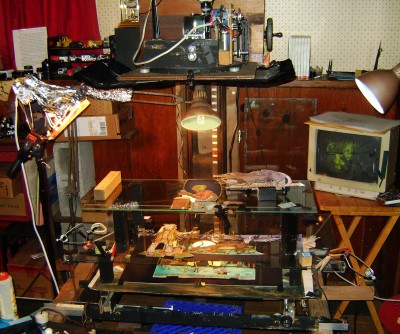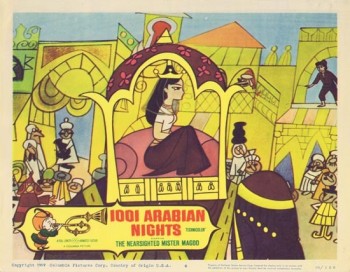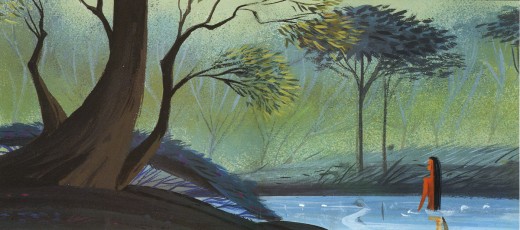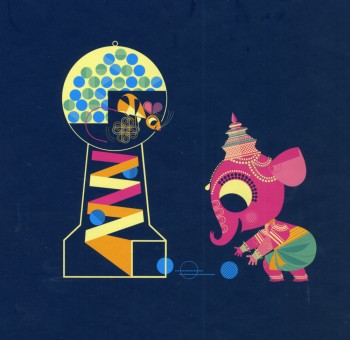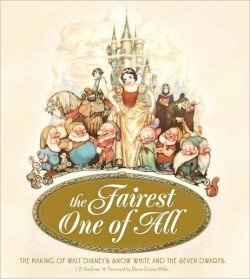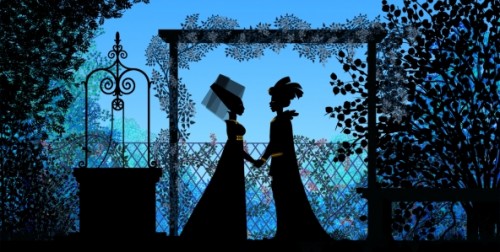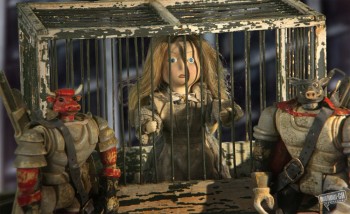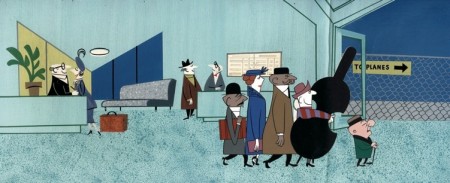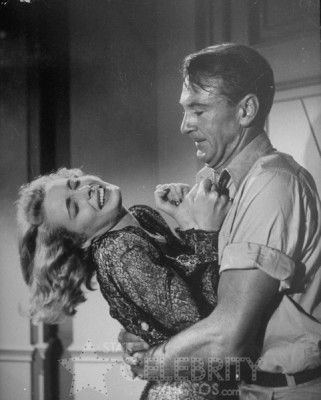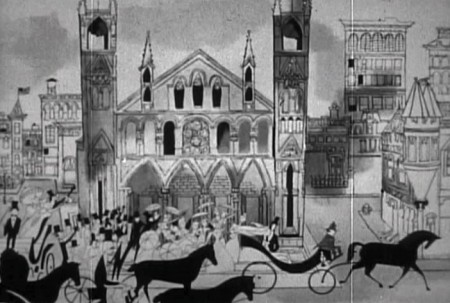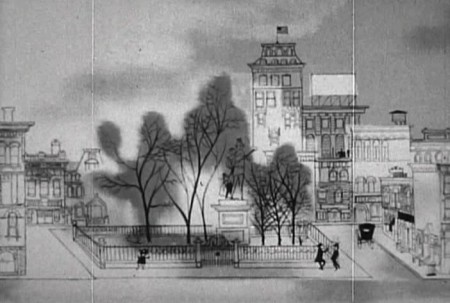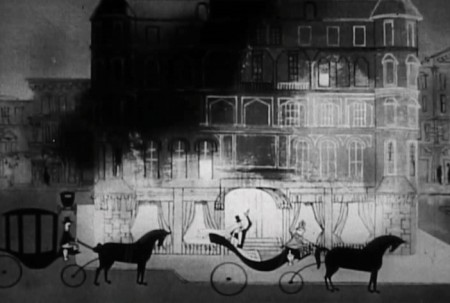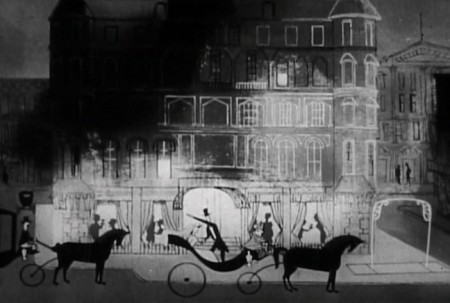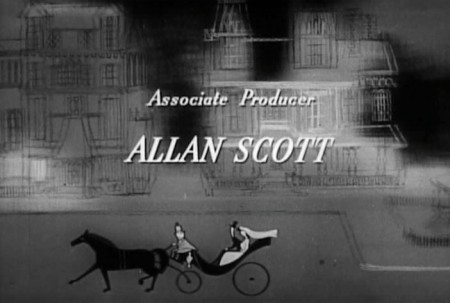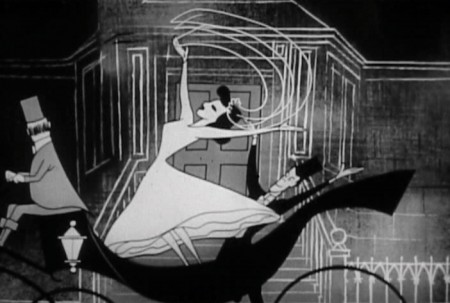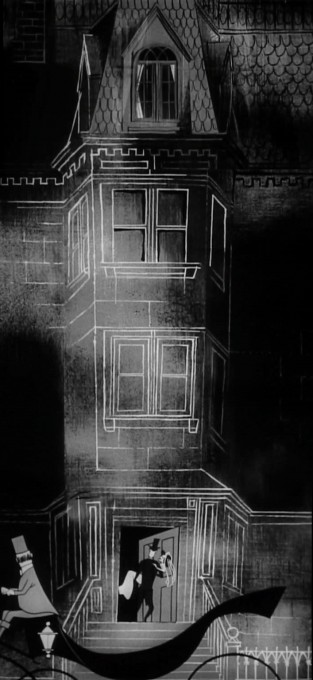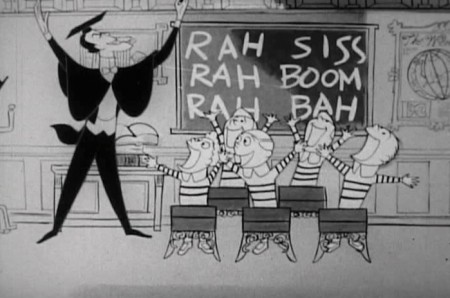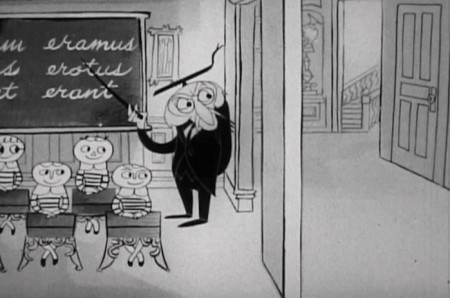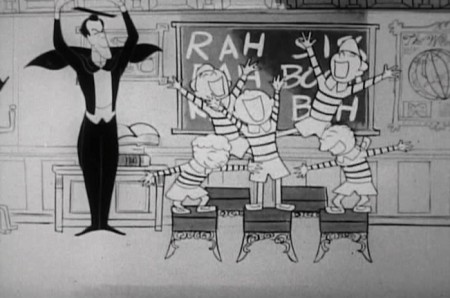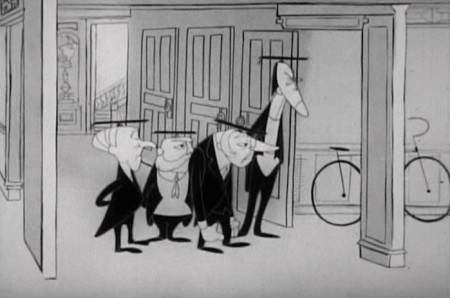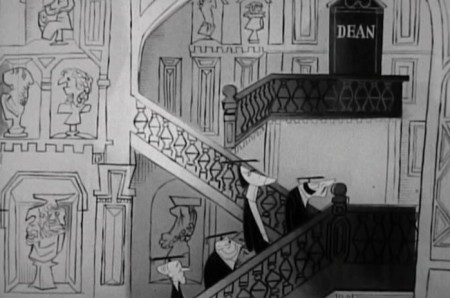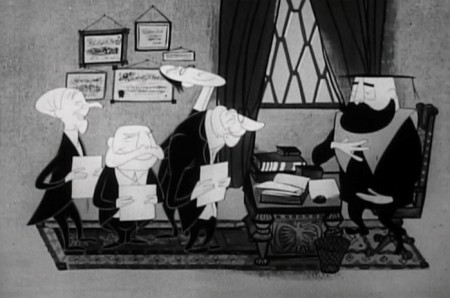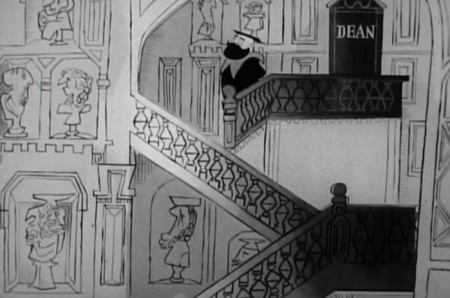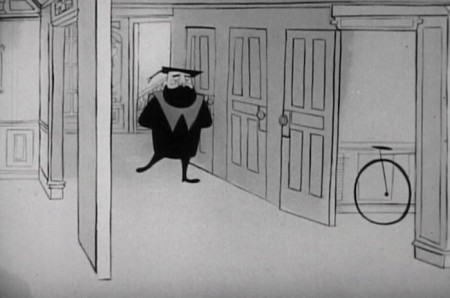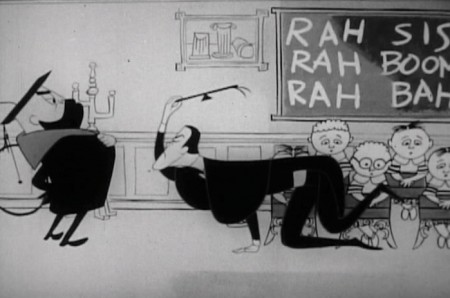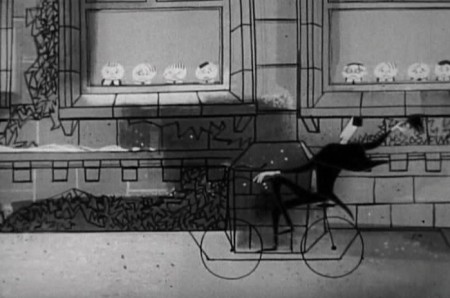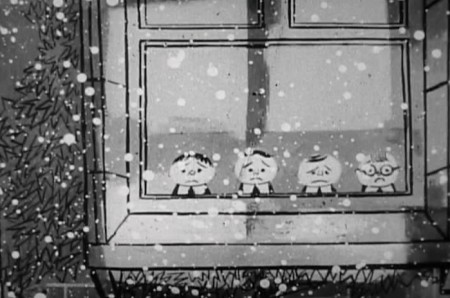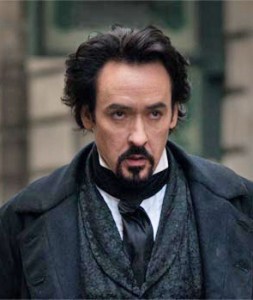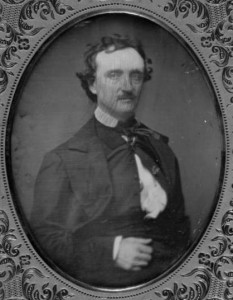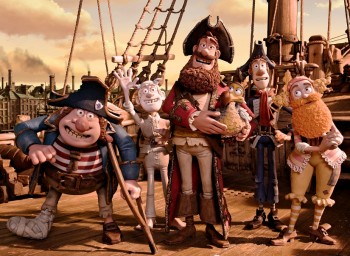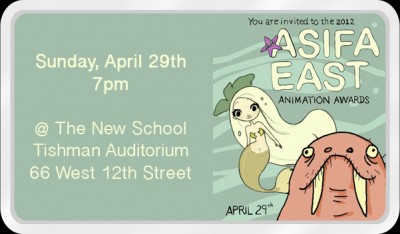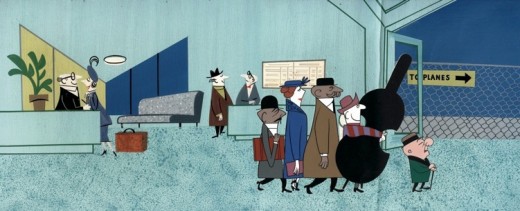Search ResultsFor "when magoo flew"
Daily post 19 Oct 2013 03:44 am
Hubley & Julian samples
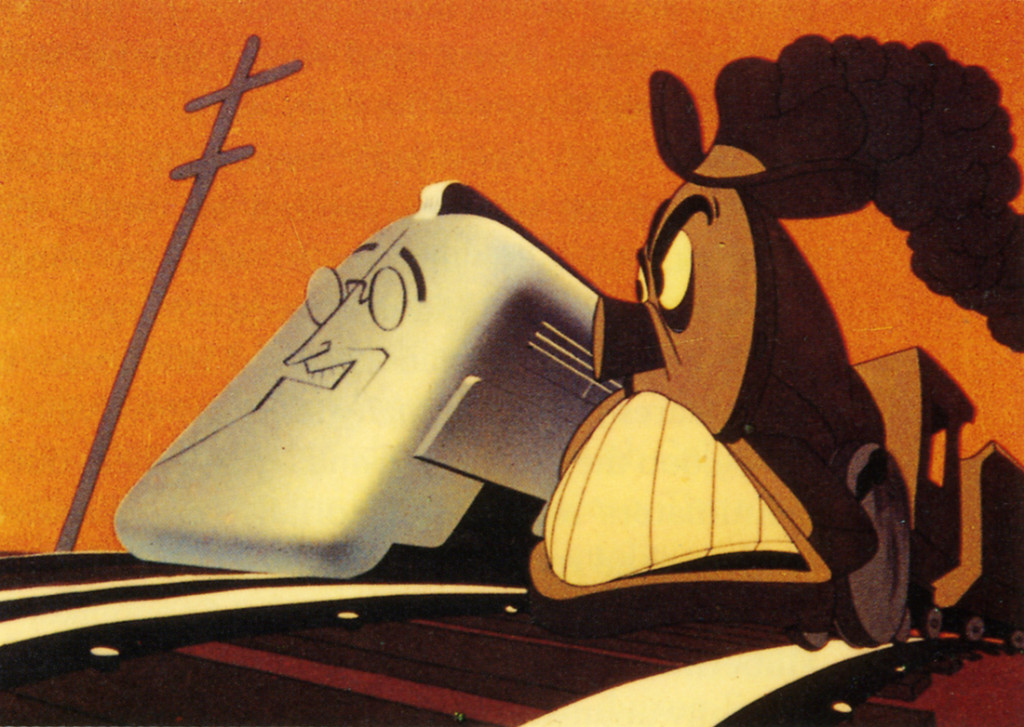 In his book, When Magoo Flew, The Rise and Fall of an Animation Studio – UPA,writer, Adam Abraham details the story of a group of artists working together a new series of films. John Hubley wasn’t always happy though he was undoubtedly one of the leaders of the artists who came together from different sources. Many from Disney, some from the US Army Signal Corps, others from Chouinard Art Institute -a school supported by Walt Disney in his attempts to gain artists for the films he made in LA.
In his book, When Magoo Flew, The Rise and Fall of an Animation Studio – UPA,writer, Adam Abraham details the story of a group of artists working together a new series of films. John Hubley wasn’t always happy though he was undoubtedly one of the leaders of the artists who came together from different sources. Many from Disney, some from the US Army Signal Corps, others from Chouinard Art Institute -a school supported by Walt Disney in his attempts to gain artists for the films he made in LA.
The stories behind the films were done wholly to advance the new art forms being discovered in Los Angeles. It was their notion that by breaking the rules of 19th Century Art animation could begin to come truly alive as an original.
Two of the artists were truly original in the approach, and when they started working together a curtain unveiled something new.
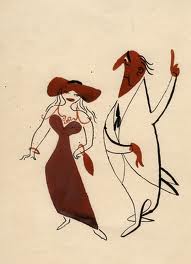 John Hubley was one of the bosses and one of of those who brought strength to the films he created. In the beginning he worked with the animator, However, he was bothereed by some of the color choices made others, particularly by BG artist artist Herb Klynn. Hubley was incensed at the ugly yellow/green that Mr. Klynn would incessantly choose. For this reason (among others) he brought in the gifted master painter Paul Julian to do the the background coloring. Hubley, himself, was a strong designer and a master painter. Who could question what he wanted to do with the department.
John Hubley was one of the bosses and one of of those who brought strength to the films he created. In the beginning he worked with the animator, However, he was bothereed by some of the color choices made others, particularly by BG artist artist Herb Klynn. Hubley was incensed at the ugly yellow/green that Mr. Klynn would incessantly choose. For this reason (among others) he brought in the gifted master painter Paul Julian to do the the background coloring. Hubley, himself, was a strong designer and a master painter. Who could question what he wanted to do with the department.
Once past a couple of near-sighted Fox and Crow films; Hubley wanted to do films about humans, not animals, and he eventually got his series featuring the near-sighted Mr. MaGoo. In the big picture, though, they were forced to follow many artistic constraints. Despite this, they two did a number of very successful shorts in changing the look and feel of animation globally.
The films done by both Hubley and Julia
Continue Reading »
Commentary 22 Dec 2012 07:48 am
Christmas Approaches
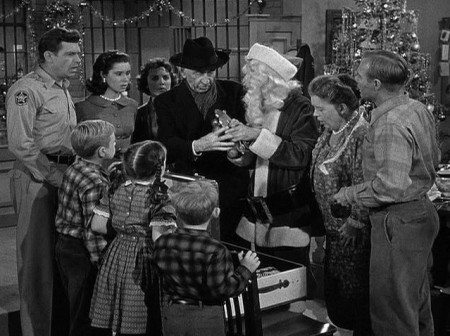
- There’s something nice, for me, about Saturday mornings. I usually wake up somewhere between 5 and 6 am. I sit down at a computer and do some writing. It may be something new for the Saturday blog or something new entirely. It always has to do with the blog, though maybe I should think about that. Perhaps do a bit of writing that might actually pay something. Naaaah! That might take away from the fun.
The two boy cats are asleep, one on the couch the other on the floor. Within a few minutes they’ll be kickboxing and making a lot of noise. I’ll have to break them up, and they’ll go back to their places, then back to sleep. Until I get off my butt and feed them some breakfast. AMC runs old episodes (I think that’s the only kind there are) of The Rifleman. This, like TV Land’s Andy Griffith Show, are a real pleasure for me. I was the age of the kids in those shows (Johnny Crawford as “Mark” and Ron Howard as “Opie”) when i watched them, originally. It brings something emotional back for me to sit through them again. It’s like comfort food is supposed to be, for me. I actually wondered if you were to take the script for one of those Andy Griffith Shows, with all the innocence about them, and remade them – it’d have to be a new cast – as is, verbatim. How would they turn out? The script has all that original, innocent emotion behind them, and none of the new cast or crew would have that. What would be lost, what would be preserved? I’d really love to try it some time with no sarcasm or irony whatsoever.
Until then, I just watch a couple of episodes every Saturday morning. Then it gets time to get things going, and the world changes back.
Kickstarter Small and Smaller
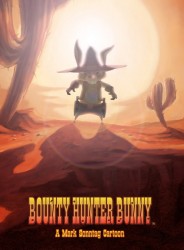 Mark Sonntag continues with his goal of raising $10,000 to make a film of “Bounty Hunter Bunny“. This is an attractive looking cgi film that seems to attempt to bring some 2D dynamics to the world of cgi. Mark’s a very astute guy; his blog takes in enormous detail fastidiously, and I would expect that to be the same of any film he produces. That’s why I have a lot of hope for this short movie.
Mark Sonntag continues with his goal of raising $10,000 to make a film of “Bounty Hunter Bunny“. This is an attractive looking cgi film that seems to attempt to bring some 2D dynamics to the world of cgi. Mark’s a very astute guy; his blog takes in enormous detail fastidiously, and I would expect that to be the same of any film he produces. That’s why I have a lot of hope for this short movie.
This would push back at what continually is the failure of the recent WB projects – attempting to animate Road Runner, Daffy and Porky in cgi moving at manic speed and pretending like the dynamics haven’t changed. I think Mark gets the difference and would succeed where the WB millions are failing.
You should, at the least, take a look at what Mark has put together on his Indiegogo page.
Here’s the Bounty Hunter Bunny journal. And
here’s Mark’s more traditional site, TagToonz
.
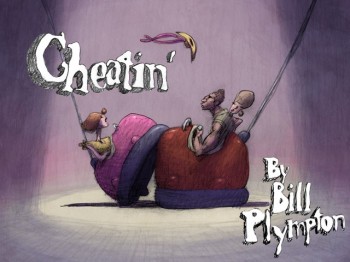
To go from one small effort to raise money to one much larger but yet, still a small effort, Bill Plympton has a Kickstarter campaign going strong. He’s trying to raise $75,000 to finish the feature he has in progress, Cheatin’. To us poor guys (Bill included) $75,000 is a hell of a lot of money, but to the world of feature animation it’s nothin’. Just take a look at some of the films out there now. Rise of the Guardians had a production budget of $145 million. Wreck-It Ralph was $168 million. Brave cost $185 million. ParaNorman was cheap in comparison at $65 million. It feels like Bill is cheatin’ with a budget of about $200 thousand.
Anyway he has a Kickstarter campaign in progress and you should take a look there. If anyone can raise that kind of money on line, he’s the guy. It’s entertaining just watching it proceed. At the moment let’s just say I’m introducing this one to you. I’ll have more to write about it in the New Year. In January, I’m starting a brand new series for this blog and am starting with Bill and his studio. There’ll be plenty to write about the Kickstarter campaign then.
And then there’s another way. Signe Baumane has requested people visit her new Facebook page dedicated to Rocks In My Pockets, the animated feature she’s been producing/directing/writing.
WORK IN PROGRESS TRAILER from Signe Baumane on Vimeo.
To start with she asks you to “Like” her page, her film. She thinks that’d help her move to the next step on Facebook to raise money through them. I really don’t know how Facebook works. I go there once a week or so and avoid the “farms” and resist the “old friends” who don’t know me. I see the little tweets that are trown there and once in a while I add my three cents to the short, pulsating conversations.
Hell, if there is a way to cntribute money to Signe from Facebook, do it. She needs the money and her film is going to be great. I saw a rough cut. I wantedto be closer to the small monitor, but it was so compelling and the story just addictive. I want to see it again, finished. Give this woman money to do what she has to do to get it done. If you can’t give it to her via Facebook, just find her home address in Brooklyn and send it there. I assume she’s going to put together a Kickstarter thing and I’ll promote that too. I believe in this movie, let me tell you.
On Monday there was a lunch at the Illustrator’s Club for a documentary film, The House I Live In. This film by Eugene Jarecki talks about the failure of America’s drug wars. The end results mean that the United States houses an enormous number of our poor and underprivileged in prisons. It’s a difficult dilemma, and there have been no successful means yet found of fighting that problem in our society. This film is one of the short-listed documentary features, and, of course, the lunch was designed to catch our attention in the hope of a vote.
I was very impressed, first off, with the Illustrator’s club. Amazing art adorns the walls at every turn. To walk past a Howard Pyle original and come upon an Al Smith original Mutt & Jeff strip alongside a Milton Caniff. The stars hung everywhere, and I was overwhelmed. The meal they served us was a wonderful and silky cut of pot roast over mashed potatoes and okra. It was an excellent afternoon as John Legend introduced the film maker, Jarecki, who spoke eloquently and made sure we all left with a copy of his DVD.
It made for a wonderful afternoon.
I came home to listen to the endless political talk about the shooting in Newtown, Connecticut. My brother’s family lives one town over, and my niece taught karate to one of the killed children. She had a photo of the girl on her cel phone. Nothing but tears this past weekend. The media treats the situation almost like pornography as they mettle in the lives of those affected. President Obama gave a brilliant speech and hopefully he will continue to lead the charge to get something done with gun laws.
Let’s jump from some capitalism to some outright theft. Eddie Fitzgerald found and embedded this guy’s YouTube video. I’ve been watching videos by this man – they’re all adaptations of dance pieces he creates scene by scene, country by country and puts them together always with the same effect. They’re absolutely joyous. Here’s the one Eddie had on his spot, and I’m posting it too. I imagine you will as well.
______________________________
I won’t take my usual turn this week by detailing a complete diary of my movie adventures this past week, but I will give you some of the highlights. On Tuesday there was a screening in the evening for David Chase’s first movie. (You’ll remember that he was the godfather of the Sopranos for HBO.) His film Not Fade Away is a love song to music of the 60′s, particularly the music of the British invasion. The movie was enjoyable, however the afterparty was excellent. The antipasto was on one level of the restaurant, and the main course was another level down. Table surrounded the upper level, and banquettes the lower level. Selecting some meats on the lower level, you couldn’t help but see a banquette or two full of Soparanos. Tony (James Gandolfini) in the corner, Paulie Walnuts (Tony Sirico) – without the grey side-burns – just across from him and Steven Van Zandt juat next to him. Little Steve had advised on the music for the film and had put together a great score of 60′s songs. Also there to be seen was Christine Lahti and plenty of others.
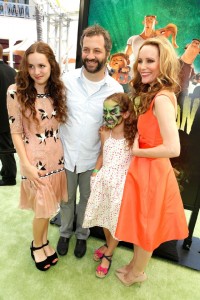 Wednesday there was the endless Quentin Tarantino film, Django Unchained. A genius of a half hour movie, and excellent 90 minute feature, and a tedious 2 ½ film. Guess which one it was. DeCaprio was really good, Sam Jackson was very fine, and Christophe Waltz made a brilliant character out of nothing, but evenhe got repetitive by his character’s end.
Wednesday there was the endless Quentin Tarantino film, Django Unchained. A genius of a half hour movie, and excellent 90 minute feature, and a tedious 2 ½ film. Guess which one it was. DeCaprio was really good, Sam Jackson was very fine, and Christophe Waltz made a brilliant character out of nothing, but evenhe got repetitive by his character’s end.
Thursday brought Matt Damon’s Promised Land. A bit preachy but quite a good script with excellent performances. Damon is so damn loveable that you can never think ill of him. He has that “Cary Grant” kind of appeal. I’ll see anything he’s in.
Friday saw This is 40 with Paul Rudd, who was excellent, and Leslie Mann who was in her best film. Leslie Mann was the director’s wife; the two children were also Judd Apatow‘s children. Let’s see who did Paul Rudd play? Many people complained of this film to me, but I loved it. Perhaps seeing it on a screen as opposed to a tv set made the difference. It really was a movie. Perhaps they thought it was one of those idiotic comedies Apatow has made in the past. Instead it’s just an honest and human story with some really funny parts.
Apatow and family appear to the right; Paul Rudd should have been a stand in for the director.
Melissa McCarthy was brilliant in improv for one scene of this film.
I intend to see The Life of Pi again this week. I’ll go to a movie house and use my card to steal into a show. I think this was the best animated film of the past year. It keeps replaying in my head. I’m going to add a stash of screen grabs later. So look in again this afternoon or maybe it’ll be tomorrow. I loved this film. I think it’s still my favorite of the year.
Speaking of screen grabs, I received a DVD copy of Combustible this week. I’ve watched it about half a dozen times. I want to make a post of screen grabs from this cartoon. I’ll ask for their permission, and if I get it you’ll see the mages in their own post. I suspect they will say, “No”. It’s a stunningly attractive animated film that keeps getting better the more you see it. The film is very complex, but it’s also very cold. From the director of Akira, this film makes a lot more sense in only 13 minutes. I thought Akira was indecipherable. I have a lot of questions I’d like to ask that director, Katsuhiro Otomo. I’ll email his publicist and see if he’ll answer any of the questions.
I’d had lunch with Chris Sullivan, the director of Consuming Spirits. What a sweet guy. Let me remind you that his film is still playing at the Film Forum through to Christmas Day. A.O. Scott called this one of the best films of the year, on his short list of those just beyond the top ten. He wouldn’t give it a hard number.
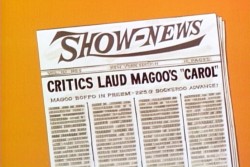 Mr.Magoo’s Christmas Carol is 50 years old this year. The celebration brings this first animated Christmas special to network television for the first time in years. This has brought a little attention. There’s a fine article in the NYTimes discussing the special and quoting all the right people: Adam Abraham who wrote the relatively recent book, When Magoo Flew: The Rise and Fall of Animation Studio UPA and Darrell Van Citters, the animation director who wrote the excellent “making of” book, Mister Magoo’s Christmas Carol: The Making of the First Animated Christmas Special. These are both fine books and, for anyone interested in the subject of UPA, must reads. Both Adam Abraham and Darrel Van Citters have excellent animation history websites which, naturally, focus on the subject of their respective books.
Mr.Magoo’s Christmas Carol is 50 years old this year. The celebration brings this first animated Christmas special to network television for the first time in years. This has brought a little attention. There’s a fine article in the NYTimes discussing the special and quoting all the right people: Adam Abraham who wrote the relatively recent book, When Magoo Flew: The Rise and Fall of Animation Studio UPA and Darrell Van Citters, the animation director who wrote the excellent “making of” book, Mister Magoo’s Christmas Carol: The Making of the First Animated Christmas Special. These are both fine books and, for anyone interested in the subject of UPA, must reads. Both Adam Abraham and Darrel Van Citters have excellent animation history websites which, naturally, focus on the subject of their respective books.
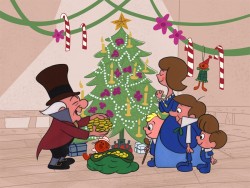 The Times article has a wonderful paragraph in it, at least for those who love both Broadway and animation:
The Times article has a wonderful paragraph in it, at least for those who love both Broadway and animation:
- Jule Styne’s wife, Margaret, even hosted a party for the premiere, with about 100 guests at the “21†Club. Richard Kiley, Ruth Gordon, Garson Kanin, Joan Collins, Anthony Newley, Lionel Bart, Stephen Sondheim, Mike Nichols and others chowed down on a roast pig — complete with apple in mouth — while watching the special on televisions supplied by RCA.
See Magoo’s Christmas Carol tonight, Dec. 22nd, at 8pm on NBC.
For those with A.D.D., Magooo is on opposite Prep and Landing and A Chipmunk Christmas, both on ABC. I somehow doubt either special will last 50 years, but you never know.
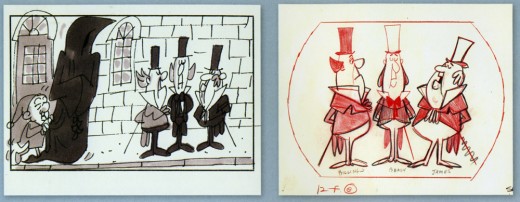
A Shirley Silvey storyboard drawing alongside a matching Layout by Sam Weiss.
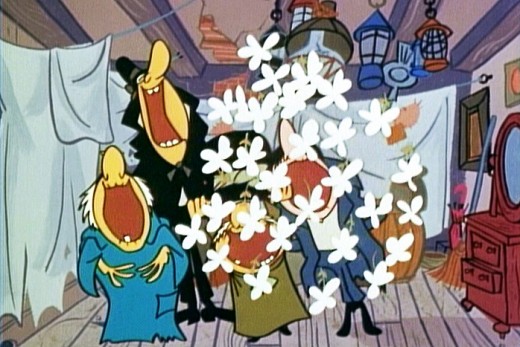
A brilliant and very limited sequence by Gerard Baldwin.
He had only two weeks to animate the “Despicables†song, yet
he completed it on time and kept it funny, personal and original.
Animation Artifacts &Commentary &Independent Animation &John Canemaker &Layout & Design 08 Dec 2012 06:23 am
Elements, Chemistry and Odd Bits
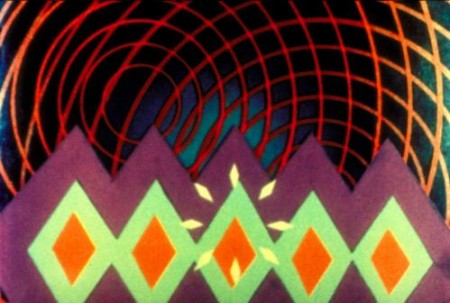
Oskar Fischinger, still from Allegretto, 1936-1943 © Center for Visual Music
- On Dec 16 in Amsterdam there will be a major exhibition of the work of Oskar Fischinger, a pioneer of animation film and abstract cinema. This opening will be an exhibition featuring various items including the films, the animation drawings, process material, the documents, correspondence, clippings, color charts, sketches, diagrams, patent drawings, and some of the sketches done (but not used) for Fantasia. Also exhibited will be notated graphic scores, material from the making of An Optical Poem, unshot animation drawings, and various other materials.
John Canemaker wrote about Fishinger for the New York Times, “Decades before computer graphics, before music videos, even before Fantasia (the 1940 version), there were the abstract animated films of Oskar Fischinger (1900-1967), master of “absolute” or nonobjective filmmaking. He was cinema’s Kandinsky, an animator who, beginning in the 1920′s in Germany, created exquisite “visual music” using geometric patterns and shapes choreographed tightly to classical music and jazz.’
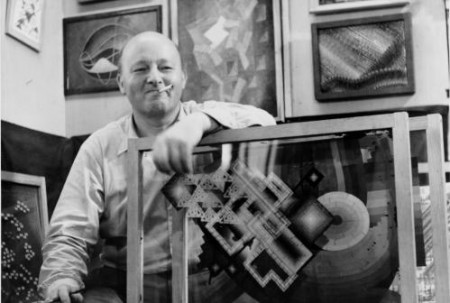
Oskar Fishinger in his Hollywood studio with panels from “Motion Painting”.
Consuming Sprits
This coming week, Wednesday Dec. 12th, Christopher Sullivan’s independent, animated feature will make its New York premiere with a week-long run at the Film Forum.
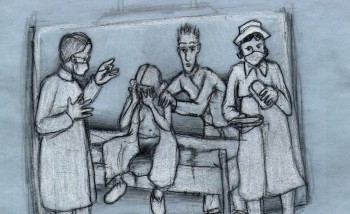 Described in the Film Forum’s press material: “The animation took 15 years of work… The characters were hand-drawn onto layers of glass which were then moved with needles and pins. The film seamlessly combines cutout animation, pencil drawing, collage, and stop-motion animation to create the haunting atmosphere of a self-contained world… (most of whose) characters walk shakily between self-medication and a bad trip… ugly characters (who) make up the most beautiful spectacle you’ve ever seen.â€
Described in the Film Forum’s press material: “The animation took 15 years of work… The characters were hand-drawn onto layers of glass which were then moved with needles and pins. The film seamlessly combines cutout animation, pencil drawing, collage, and stop-motion animation to create the haunting atmosphere of a self-contained world… (most of whose) characters walk shakily between self-medication and a bad trip… ugly characters (who) make up the most beautiful spectacle you’ve ever seen.â€
I’ve been looking forward to seeing this film for quite some time. Finally, I’ve been able to confirm arrangements to see it, and I will review it. I’m ready, given all the mediocre work I’ve seen lately.
Meet the film maker
Christopher Sullivan will be there IN PERSON! at the following screenings:
December 14 | 6:30pm
December 15 | 6:30pm
MoMA in Europe
This week, upcoming, the Museum of Modern Art will present a program of older European animation, and quite a few great classics will be screened in one very powerful program that will be shown three times. Trust me, if you don’t know these shorts, they are brilliant – all of them – and there is not one you should miss. Here’s a list of the films in the program:
Animation Abroad, 1946–59
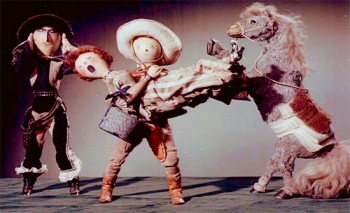 Arie Prerie (Song of the Prairie)
Arie Prerie (Song of the Prairie)
1948. Czechoslovakia. Directed by Jiri Trnka. 21 min.
A Litte Phantasy on a 19th Century Painting
1946. Canada. Directed by Norman McLaren. 3 min.
Fiddle-de-dee
1947. Canada. Directed by Norman McLaren. 4 min.
Charley’s March of Time
1948. Great Britain. 1948. Directed by John Halas and Joy Batchelor. 9 min.
A Phantasy
1952. Canada. Directed by Norman McLaren. 8 min.
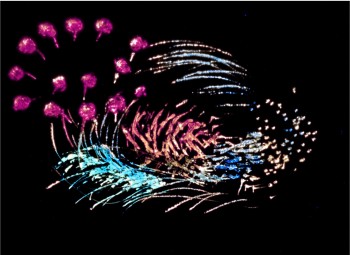 Blinkity Blank
Blinkity Blank
1955. Canada. Directed by Norman McLaren. 5 min.
Thumbelina
1955. Great Britain. Directed by Lotte Reiniger. 11 min.
Concerto for a Submachine Gun
1958. Yugoslavia. Directed by Dusan Vukotic. 13 min.
Les Astronautes
1959. France. Directed by Walerian Borowczyk with Chris Marker. 13 min.
Program 87 min.
Wednesday, December 12, 2012, 1:30 p.m., Theater 2, T2
Thursday, December 13, 2012, 1:30 p.m., Theater 2, T2
Friday, December 14, 2012, 1:30 p.m., Theater 2, T2
Nest week, and I’ll post the list next Saturday, there will be a number of Hollywood Cartoons that will be screened. Chuck Jones, Robert McKimson, Hanna & Barbera, Jack Hannah and Ward Kimball. They’re all represented.
Pups for Sale
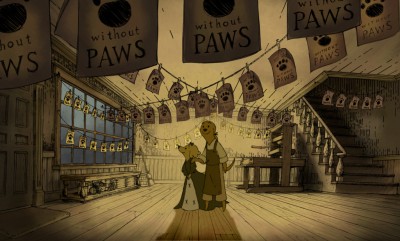 – As of yesterday, Friday, the Pups of Liberty became available for sale to teachers as well as the public, If you go to izzit.org or Amazon.com, you’ll see the assets that are available; indeed, they both link to an educational video, entitled The Pups of Liberty.
– As of yesterday, Friday, the Pups of Liberty became available for sale to teachers as well as the public, If you go to izzit.org or Amazon.com, you’ll see the assets that are available; indeed, they both link to an educational video, entitled The Pups of Liberty.
Perhaps you’ll remember the posts I published a while back on this short film produced by Bert and Jennifer Klein. I put those several articles together into one here to best showcase the story of this video. With the help of an all-star animation team (artists including: James Lopez (Hercules, Emperor’s New Groove, Flushed Away and Princess and the Frog), Eric Goldberg (Aladdin, Fantasia 2000, and Princess and the Frog), Barry Atkinson (Prince of Egypt, American Tail and The Lion King), and Mark Henn (The Little Mermaid, Beauty and the Beast, Aladdin, Muland and Princess and the Frog) Jennifer and Bert created this Revolutionary War-based film. It offered history as entertainment and allowed audiences to learn from a very entertaining series.
Now, the Kleins are not only making the video available for sale but have a new activities website which expands on that video.
This is a smart idea as Bert and Jennifer Klein seek to develop a new market and a new way to sell a creative product. If you’d like to learn more, take a look at these few clips of the animation. Here or here or here.
This Week’s Films
The schedule continues with our watching a lot of films on the run up to the Oscar nominations. By “us” I mean the people of the Academy, those who elect to see the films on a big screen before they vote. I’m sure a lot of members take the easy way out and watch DVDs of the current movies. I won’t hear this way out. As a matter of fact, they’ve asked us to accept the films via download. We’d watch the movies – the movies we’re voting for as Oscar contenders – via download over the internet. Sort of like NETFLIX. I still want to think of them as “movies”, I want the burden of going to a theater to watch them in a public place with other differing viewers, all inconvenienced at the same time. That is part of the experience, isn’t it?
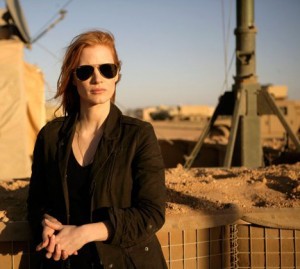 So, anyway, this week started off with Zero Dark Thirty. (I guess that’s supposed to mean 12:30 am – or half past midnight, in the dark.) On Tuesday the movie got the NYFilm Critic’s award for Best Film of the Year. I was hot to see the movie.
So, anyway, this week started off with Zero Dark Thirty. (I guess that’s supposed to mean 12:30 am – or half past midnight, in the dark.) On Tuesday the movie got the NYFilm Critic’s award for Best Film of the Year. I was hot to see the movie.
Turns out, to me, it was just one step above a TV movie version of the raid on Osama Bin Laden campsite to capture the guy. This film had no poetry in it and wasn’t about much other than the raid we watched. I didn’t like it. Dull. I did like Kateryn Bigelow’s last film, The Hurt Locker. But this film wasn’t that. I thought Jessica Chastain was miscast even though I am a big fan of hers. In fact there’s a Thursday luncheon where I’ll meet Ms. Bigelow and Ms. Chastain. I’m looking forward to that but have to lie if they ask what I thought of the film.
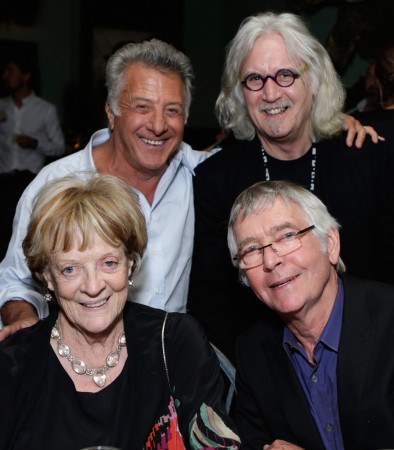
top – Dustin Hoffman, Bill Connolly
bot – Maggie Smith, Tom Courtney
On Wednesday, there was the fllm directed by Dustin Hoffman, The Quartet. This one was great. No miscasting here. Maggie Smith and Tom Courtney were brilliant. Billy Connolly couldn’t have been better, and it was easy to love Pauline Collins. She’s always great. The script by Ron Harwood from his own play was sparkling and always alive. The film was funny, warm, about people and always alive. Just great and human. Top drawer work. After the screening there was a penthouse cocktail party with a nice view, good free vodka or wine, and a chance to tell Dustin Hoffman and Billy Connolly about how good they were. Heidi told Mr. connolly how much she hliked his voice work in Brave, I just told him he was great, great, great. If I didn’t realize how stupid I sounded, I probably would have said a couple more “greats”. See this film for all the brilliant talent on display and the fun you’ll have watching it.
UPA
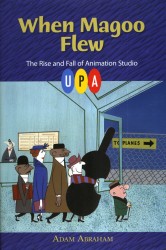 – Thursday night, I skipped the screening of Hyde Park to attend the lecture across town. Adam Abraham was speaking on the back of his book, When Magoo Flew: The Rise and Fall of Animation Studio UPA . The book was remarkable to me, and I was looking forward to meeting the author. At first there were very few people in attendance, but it soon filled up. I was happy to see friends, John Canemaker and Amid Amidi there.
– Thursday night, I skipped the screening of Hyde Park to attend the lecture across town. Adam Abraham was speaking on the back of his book, When Magoo Flew: The Rise and Fall of Animation Studio UPA . The book was remarkable to me, and I was looking forward to meeting the author. At first there were very few people in attendance, but it soon filled up. I was happy to see friends, John Canemaker and Amid Amidi there.
Adam’s talk was well done and ended with the screening of five films: Gerald McBoing Boing, Magoo Express, The Tell Tale Heart, Rooty Toot Toot and a rarely seen live action promotion for Magoo’s 1001 Arabian Nights, called: A Princess for Magoo.
I enjoyed the program and was pleased to meet Adam after the talk. Amid Amidi and I walked the few blocks to the subway and went home. A nice evening.
Back to the Routine
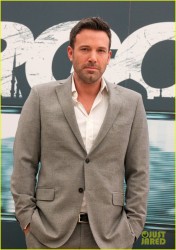 – On Friday, I attended a luncheon for the film Argo. Ben Affleck, and several key people from the film attended and answered our questions about the movie while we ate at the Four Seasons Restaurant.
– On Friday, I attended a luncheon for the film Argo. Ben Affleck, and several key people from the film attended and answered our questions about the movie while we ate at the Four Seasons Restaurant.
The movie is promoted as some kind of recreation of actual events, and I’m sure it is. However, the film we see on the screen works just too well as a typical action-adventure sort of film, that it’s hard to accept its believability, regardless of how much is true. The climactic scene as the hostages are flying away from the Iranian police is just too Hollywood to be a reality, and Mr. Affleck admitted as much, making a joke of the idea. As an action film it works, but I wished for it to dig a little deeper.
A quick steak lunch and a return home. There was a screening of a documentary called West of Memphis which I was scheduled to attend last night, but I just didn’t feel up to it. So I stayed home. Enough movies for one week.
Books &Daily post 29 Sep 2012 06:55 am
Egos, Books, and Michel Ocelot
There’s been a relatively short conversation going on at the comment section of my blog for an older piece I’d repeated this past week. The discussion has been about Eyvind Earle. The first few visitors who commented all wanted to express their dislike of this film (particularly the story) and Eyvind Earle’s design work, in particular. “Scott’s” dislike of Mr. Earle’s work extends to his personal attitude while working on the film. He, according to “Scott”, was thick headed and wouldn’t listen to any requested changes to his designs, allowing his ego to take charge of the work. (I’m not sure that I see that on the screen, nor did I really feel that when I met the man when I got to spend an afternoon with him as I accompanied Mike Barrier on an interview. I admit it is possible though.)
In fact, I think the ego is essential in breaking new waves and advancing the art form. Adam Abraham in his book When Magoo Flew writes about the ego of John Hubley in running his productions at UPA. If he wanted a specific blue, that’s all that he would settle for. The report is that he was oppressively insistent on it being his way only. I worked for Hubley for years and never got to see that side of the man. Oh, there was a well deserved and big ego there, but it never got in the way of the art being created.
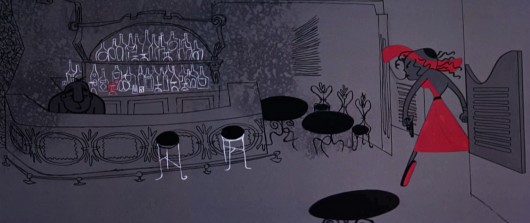
Rooty Toot Toot
We’ve seen Bill Peet complain about Bill Tytla‘s use of his (Peet’s) drawings while working on Dumbo. According to what I’ve read, Peet complains that Tytla took full credit for the sequence of baby Dumbo running in and around his mother’s legs, when Peet felt it was his scene, his key drawings that made the scene the perfect piece that it was.
Chuck Jones, while working briefly for Disney (on Sleeping Beauty), told Walt that he had to leave the studio. When Disney asked what job Jones really wanted at the studio, Jones said, “Yours.” He felt that only Disney’s job was suitable for him. Talk about ego. The ego was even larger than that when you realize that it was Jones, hmself, that told me that story – however real it actuall was. The egos of Jones and Clampett and even Freleng vie over who created what character.
Egos are necessary in an industry of craftspeople and artisans, especially when an artist is trying to get something brilliant out of them. Thomas, Johnston, and even Kahl were brilliant actors with amazing abilities of draftsmanship. But the film, the bigger picture, needed a direction which Earle gave it. Just look at the wretched Reitherman films to see what Thomas, Johnston and Kahl turned out without the strong, smart director who was also an artist. Tytla took animation to another level, he was truly an artist, himself, but look at the miserable little films he directed when he left Disney’s studio. Even the support system of that studio wouldn’t have helped Leprechauns Gold or Snap Happy. (Mind you, I love Snap Happy, but it has no relation to art.)
Here’s a small piece David Parfitt wrote:
- Tytla was a tough guy who used abusive language and irritated his fellow animators. Ken Anderson (Disney Legend for Animation and Imagineering) went to Walt Disney to express frustration at the way Tytla treated his coworkers. Walt Disney replied, “What do you think of Chernabog, the God of evil, in ‘Fantasia’? What do you think of Stromboli in ‘Pinocchio’?†Anderson (the art director for both films) replied, “They are some of the most powerful and vicious villains we’ve ever done.†Walt Disney looked at Anderson and said, “Where do you think all that anger comes from?†Vladimir Tytla was a maverick who needed to release anger and energy to manifest some of the most powerful imagery ever produced by the Disney Studios. A maverick is difficult for a company to grapple with because of their abrasiveness and the way they go against the way things typically run. Yet out of the agitation and irritation often comes a new direction that could secure a company’s future.
Sleeping Beauty changed the Disney studio forever. The animators and artists there, with the exception of Ward Kimball and a few others, fought against the use of 20th century graphics in their films, yet UPA’s influence slowly crept into the mix. Finally when Walt Disney, himself, chose Eyvind Earle and put full support behind him to design this film as he saw fit. The animators all fought Earle and continued to bad mouth him to the end of their days. Yet Earle’s style, as well as Tom Oreb‘s great character designs for that film, are frequently copied by the new generations of artists. The backgrounds and some of the character design are stolen directly from Sleeping Beauty. Even though the SB art is a play on 15th Century manuscripts and art, it was used for the Pocahontas forests.
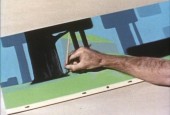
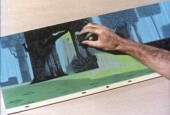
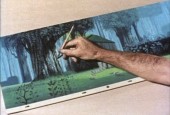
Painting Sleeping Beauty
Nothing at Disney, with the possible exception of Bedknobs and Broomsticks went back to the past to illustrate their films henceforth. Until, of course, today’s new artists in animation who just steal from other past films. Bluth‘s Small One or is virtually without style. Tim Burton is possibly the only exception I can see of this current view of the state of animation. The regurgitated past of other artists who deservedly had egos aglow. We go on. Perhaps someone like Genndy Tartakovsky will bring some of the panasche he brought to Samurai Jack.
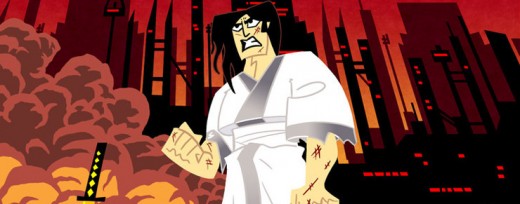
Samurai Jack
By the way, there’s a good interview with Tartakovsky on this week’s on-line version of the Village Voice.
Books
.
- There are a couple of books I’d like to write about.
.
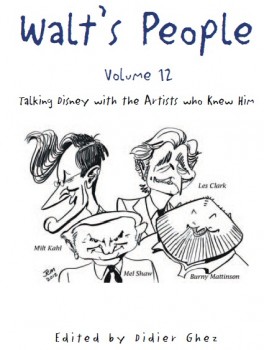
- Let me mention Didier Ghez‘ latest volume of his interview series, Walt’s People.
Just released is Walt’s People – Vol. 12. Just the idea of 12 volumes of any book in print, is quite extraordinary, and amazing feat for Didier Ghez to pull off.
I own about a half dozen of this series and have read all of them at least twice. Most of the interviews are exceptional, some are smart, and the rest are just very good. In all there are those interviews that give us some real insight into the process and history of the making of animated films by the professionals who did it. Les Clark, Larry Clemmons, Charlie Downs, Al Eugster, Sammy Fain, Milt Kahl, Burny Mattinson, Paul Murry, and Mel Shaw are among the many who are interviewed in depth for this new volume. Some of our greatest historians (Robin Allan, Michael Barrier, Albert Becattini, John Canemaker, John Culhane, Pete Docter, Chris Finch, J.B. Kaufman, Jim Korkis, Dave Smith, and Charles Solomon among others) conduct the interviews.
It’s just another great volume in the series. You should own them all; I should own them all, to be honest, and I will.
Ganesha’s Sweet Tooth
- As previously reviewed on this blog, Sanjay Patel will see his first children’s book, Ganesha’s Sweet Tooth released this week by Chronicle Books. I have a sore spot for Mr. Patel’s work. He’s an artist who works by day at Pixar and is an artist, with his own very defined style, working extensively after hours.
I’ve reviewed many of his books and have a real fondness for The Ramayana. Were I you, looking to explore this artist’s work, I’d buy Ganesha’s Sweet Tooth. Once you have it and want more – you will – go for The Ramayana. It’s a brilliant masterwork.
Snow White x 2
- Unless you’ve been hiding under a rock, if you’re an animation fan, you know that the brilliant historian, J.B. Kaufman, has not one but TWO books on Snow White about to appear on the market.
The Fairest One of All: The Making of Walt Disney’s Snow White and the Seven Dwarfs and
Snow White and the Seven Dwarfs: The Art and Creation of Walt Disney’s Classic Animated Film
are the two titles by Kaufman that focus in great depth on that film and its development. This is to celebrate the 75th anniversary of the feature, and will coincide with a display that will appear soon at the Walt Disney Family Museum in San Francisco.
Both books come from the Walt Disney Family Foundation in conjunction with the Walt Disney Family Museum. I’ve seen the Art of Creation book, and was completely taken with it. I will most definitely own both books. The film means much to me, and I want to own anything Kaufman writes. It’s a no-brainer – double my pleasure.
By the way, part of the reason I’m looking forward to reading these two books is to compare it with Michael Barrier‘s amazing writing on this period at Disney’s studio. In Hollywood Cartoons, there’s a large part of the book dedicated to the development andcreation of this particular film. Then in The Animated Man: A Life of Walt Disney Barrier tells the same information but from a different perspective entirely. This biography of Disney is wholly involved with Walt Disney, the man and artist. It’s a unique turn that we only see in the poorly written Diane Disney Miller book, The Story of Walt Disney. As Walt’s young daughter she could see the story no other way than from his perspective. While waiting for the Kaufman books to come out, read either of Barrier’s books for the best, to date, version of the Snow White story. It’s strong writing.
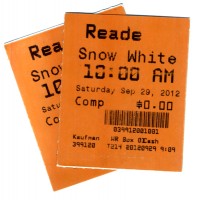 It’s appropriate that I was invited to a 10am screening of Snow White at Lincoln Center this morning. It’s part of the NY Film Festival’s 50th anniversary celebration. Eric Goldberg introduced the film with a brief and smart little talk about the animation. Talking about The Old Mill as a test run for the Multiplane Camera, talking about the Three Little Pigs first offering characters that looked alike but had characterization defined by their animation (as did the dwarfs), talking about The Goddess of Spring being an enormous failure for Ham Luske who succeeded animating Snow White. It was nice to say hello to Eric prior to the film. We haven’t seen each other in about five years. It was nice also to see the film projected. I saw the movie on tv/dvd only a couple of weeks ago, but it’s a very different experience on the big screen. The digital transfer was glorious, merciless and disastrous. The ink lines were so sharp that you could actually feel how deeply the crow quills cut into the cels. However there were many points where individual frames had slight digital distortion to hurt the ink lines, and the magic mirror actually had the detritus of digital compression across the center of the mirror. Someone should have been there to supervise the transfer.
It’s appropriate that I was invited to a 10am screening of Snow White at Lincoln Center this morning. It’s part of the NY Film Festival’s 50th anniversary celebration. Eric Goldberg introduced the film with a brief and smart little talk about the animation. Talking about The Old Mill as a test run for the Multiplane Camera, talking about the Three Little Pigs first offering characters that looked alike but had characterization defined by their animation (as did the dwarfs), talking about The Goddess of Spring being an enormous failure for Ham Luske who succeeded animating Snow White. It was nice to say hello to Eric prior to the film. We haven’t seen each other in about five years. It was nice also to see the film projected. I saw the movie on tv/dvd only a couple of weeks ago, but it’s a very different experience on the big screen. The digital transfer was glorious, merciless and disastrous. The ink lines were so sharp that you could actually feel how deeply the crow quills cut into the cels. However there were many points where individual frames had slight digital distortion to hurt the ink lines, and the magic mirror actually had the detritus of digital compression across the center of the mirror. Someone should have been there to supervise the transfer.
Paperman played prior to Snow White. It was animated cgi, then flattened and lines were added atop the flattened drawings. I can’t for the life of me understand why it wasn’t just animated by hand. It would have cut the cost in half and had more life to it. Sorry, I don’t think it worth the Oscar. Though you never know it may be the best film, this year.
Tales of the Night
- Michel Ocelot has received another excellent review from the NYTimes. Tales of the Nightis reviewed by Andy Webster in the Times, and is Ocelot’s latest feature length animated film – his first in 3D – and the reviews are sensational. It’s screening as part of the Children’s International Film Festival and plays at New York’s IFC Theater through next Tuesday. This is a silhouette film in brilliant color.
His films are beautiful and deserve to be seen in a theater. I’d heartily recommend getting to the theater if you have the chance. Hopefully the distributor will submit this one for Oscar consideration. Though the look is 2D, the graphics are done via cgi as was the case with his past films, including Azur & Asmar, Kirikou et les betes sauvages, Princes and Princesses, and Kirikou and the Sorceress.
Some amazing animation is coming out of France these days.
More Reviews
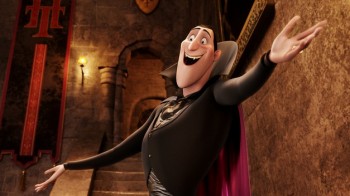 Now to the bigger release for the smaller film department:
Now to the bigger release for the smaller film department:
Adam Sandler‘s second animated feature, Hotel Transylvania, opened to mostly poor reviews by 2nd string reviewers.
NYTimes sent Neil Genzlinger to give his negative review. The most positive line is: “The movie loses its originality as it rolls toward its predictable conclusion, but it’s still lovely to look at.”
Someone named Sara Stewart reviews the film for the NYPost and gives it a middling 2½ stars. “Director Genndy Tartakovsky (“The Powerpuff Girls,†“Samurai Jackâ€) is a natural fit for this kid-and-parent-friendly flick. The animator’s wit and attention to detail enliven a collection of well-known ghosts and ghouls. (Though Tartakovsky’s more traditional TV-cartoon style is still superior, as evidenced by his playful closing credits.)”
Joe Neumaier, the 2nd rate first stringer of the NYDaily news gave it a mostly positive 3 star review. “This being a Sandler movie, the humor skews toward the infantile (fart jokes, peeing baby werewolves). But the sleek visuals are rich and glossy, placing the characters, who look like Halloween door decorations, in baroque hallways or secret passageways.”
I enjoy the reviews in The Onion, and their review for this film by Tasha Robinson doesn’t disappoint. A C+: “Tartakovsky gets a long way on wild design and visually daring sequences. His work has always been adventurous, experimental, and conceptually creative, and he hasn’t lost any of his energy or capacity for staging a memorable setpiece.”
Whatever happened to the feature length version of Samurai Jack that J.J. Abrams was going to produce wth Tartakovsky directing?
Commentary 08 Sep 2012 04:36 am
Comment Tally View
- You gotta love Thad Komorowski. His site goes into some real hard-nosed animation history like ironing out all those Production Numbers from the Warner Bros and MGM shorts. His work in this area pushed Adam Abraham to assemble the Prod. Numbers for UPA cartoons and Pietro Shakarian assembled the numbers for the Lantz cartoons (or should I have written cartunes?).
Thad also has an excellent piece on his blog about the early color films of Chuck Jones. Yes, we’re talking Sniffles.
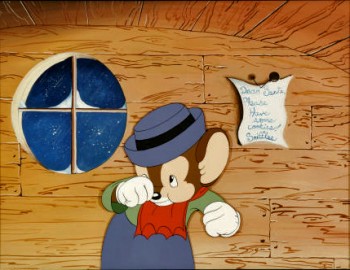 For quite some time, I’ve read many an article about these films constantly putting them down. Thad’s an original – the first I know to find something solid in them. (Though I have to say he does it with an apology in his throat.) The reason behind the post is to review a new DVD on the market, Looney Tunes Mouse Chronicles, a collection of Jones cartoons that feature mice. All the Sniffles and the Hubie and Bertie shorts.
For quite some time, I’ve read many an article about these films constantly putting them down. Thad’s an original – the first I know to find something solid in them. (Though I have to say he does it with an apology in his throat.) The reason behind the post is to review a new DVD on the market, Looney Tunes Mouse Chronicles, a collection of Jones cartoons that feature mice. All the Sniffles and the Hubie and Bertie shorts.
These Sniffles films really got me when I was young. I couldn’t get enough of Bedtime for Sniffles. I always thought that film was brilliant – I still think that. I can remember every scene in that movie; I’ve watched it so many times. Jones took WB close to what Disney had led the industry in doing – emotional drama. Some might say overemotional drama – which often veers too close to “cute” for anyone’s taste. These are children’s films, yet Jones was able to find a real conflict in this one-character cartoon, Bedtime for Sniffles. Poor Sniffles just wants to wait up to see Santa. You always feel that Jones is beaming with pride after pulling off such a stunt, and Thad talks in depth (but never quite enough) about Jones’ ego. I think this is probably half of what Jones offers in his films; his ego is the backbone. This was a principal part of the Jones oeuvre. It’s blatantly part of What’s Opera Doc, it drives One Froggy Evening, and it’s in the spine of Bedtime for Sniffles. Maybe it’s just starting to shine in the Sniffles short, but it’s definitely there.
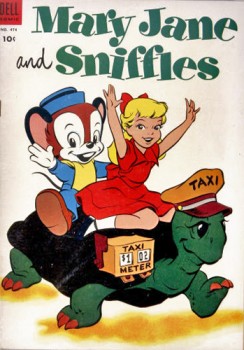 There was this odd period in animation history. Just prior to WWII, cartoons got cute, cuter, cutest. Merbabies, kittens galore, underground gnomes bringing Spring, countless trips to The Milky Way, and all the cartoon stars get a pack of nephews to follow them. What was in the milk that adults drank on the way to the movie theater? Why were these cute cartoons so popular during this short period? The Milky Way might have played with Ninotchka; Merbabies might have doubled with The Adventures of Robin Hood or Jezebel. What was it that the adults of that decade saw that they loved? I’m so far removed from the thoughts of those pre-War people that I certainly can’t judge; I can only wonder. Sniffles was certainly a product of this wave of those animation shorts, and in many ways he stays current. (I love that they revived him for the WB comic books of the late fifties and sixties: “Magic words of poof poof pifffles. Make me just as small as Sniffles.” This was the chant Mary Jane would recite to begin a comic adventure story as she grew tiny.) Warner Bros hasn’t dropped Sniffles altogether; they just don’t use him too often.
There was this odd period in animation history. Just prior to WWII, cartoons got cute, cuter, cutest. Merbabies, kittens galore, underground gnomes bringing Spring, countless trips to The Milky Way, and all the cartoon stars get a pack of nephews to follow them. What was in the milk that adults drank on the way to the movie theater? Why were these cute cartoons so popular during this short period? The Milky Way might have played with Ninotchka; Merbabies might have doubled with The Adventures of Robin Hood or Jezebel. What was it that the adults of that decade saw that they loved? I’m so far removed from the thoughts of those pre-War people that I certainly can’t judge; I can only wonder. Sniffles was certainly a product of this wave of those animation shorts, and in many ways he stays current. (I love that they revived him for the WB comic books of the late fifties and sixties: “Magic words of poof poof pifffles. Make me just as small as Sniffles.” This was the chant Mary Jane would recite to begin a comic adventure story as she grew tiny.) Warner Bros hasn’t dropped Sniffles altogether; they just don’t use him too often.
Anyway, I was taken with this post by Thad, and he takes it into serious history, where I just reminisce. I will take that film apart though. I may just pull a lot of frame grabs over the weekend.
Storycorps Kickstarting
- I received an email from Storycorps promoting their latest film. These excellent animation pieces have all been directed and produced by Mike and Tim Rauch with art direction by Bill Wray. The films have a style all their own somewhere between John K and Warner Bros. The tracks are all live storytelling done by Storycorps in their recording booth.
Here’s the latest film they’ve completed:
Facundo the Great
There are also promos with the YouTube video that try to get you to Kickstarter to their fundraising campaign so that they can make their first full half hour special. They do good work, and it’s worth the investment if you like. (I can’t imagine that the $25,000 they’re seeking is the complete budget for a half-hour show.) The final date is approaching within the week.
An interesting thing about the promo-emails that came to me were the names mentioned. After announcing the name of the piece, there’s the sentence, “It’s a spirited childhood story that includes amazing backgrounds from the legendary artist, Bill Wray.”
The only other name listed in the entire letter is “Amy Adsley, Marketing and Communications, StoryCorps” – who signed the letter.
The next day I received the very same letter with a different marketing person. I trashed both emails, sorry I didn’t save the new name.
I hate to say it, but I think the Rauch Brothers have never gotten their proper due from Storycorps considering they sought the connection with Storycorps and did the first couple of films with their own money. Once it was obvious that this was the way to go, Storycorps took charge, and I see the names of Mike and Tim shrinking away from the publicity. I suspect nothing is going on except that the brothers just aren’t getting their due. They’re the ones that pull the films together and make sure they work.
But then this is all speculation on my part. I’m sure all is right in Storycorps land, but it is an observation that I’ve made. I may as well cause some trouble since I have nothing to do with the films or Storycorps or the Brothers (except that I like them both.) If I were they, I’d put my names a little louder in my future contracts.
Toys in Review
The critics, as might have been expected, had differing views of the new animated feature, Toys in the Attic. Per Rotten Tomatoes, the film garners an 80% positive among the reviews they’ve collected. In New York the thoughts are not too different:
- Manohla Dargis of the NY Times gave it a somewhat positive review: “‘Toys in the Attic’ isn’t as unsettling as Mr. Svankmajer’s work, but even in this English-language version, it’s scarcely a cute and cuddly family film of the generic type often foisted on American tots.”
- The NY Post‘s Farran Smith Nehme gives the film three stars and says: “Stop-motion animated film has a predictable plot but vividly imaginative, engrossing visuals.” “The movie is passionately retro, but Barta shows his methods can create a world every bit as engrossing as the latest CGI.”
Offbook
There’s a new YouTube channel from PBS Digital Studios. Their most recent episode of the “Offbook” series is The Art of Animation and Motion Graphics: a brief view of animation and a look at today’s latest innovations. John Canemaker is featured in the film. He gives a short look at the varying forms within the medium. It’s a cursory look for the A.D.D. generation, under the guise of “informational”.
“Offbook”
Apparently a new video is released every other Thursday under the “Offbook” title. To date there are 12 such videos. The one on Typography is good, as is the brief introduction to Title Design and another on Street Art.
POE Continues
- It was great, these last two weeks, watching first the Republican convention, then the Democratic convention. The two were so different, one from the other. One was workman-like; the other was inspirational. One was full of lying accusations and lots of promises that didn’t quite jive with plans they’d written down. The other featured speeches that sometimes veered into poetry. Night after night the Dems left me charged.
All the while I was doing a scene from POE, over and over and over, trying to tighten the
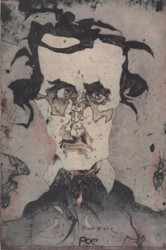 style. Finally, on take 25 (or thereabouts) I was content to leave it. Locked. I started the next scene, and it feels the same. I’m already on take three, and I haven’t started the animation yet.
style. Finally, on take 25 (or thereabouts) I was content to leave it. Locked. I started the next scene, and it feels the same. I’m already on take three, and I haven’t started the animation yet.
It’ll work out, I’m sure.
Meanwhile Jonathan Annand wrote: “There’s a short run exhibition at the Brandywine Museum starting September 8th that you might be interested in, if you don’t already know about it: Picturing Poe: Illustrations for Edgar Allan Poe’s Stories and Poems. The publicity for the show reads: Édouard Manet, Gustave Doré, Paul Gauguin, James Ensor, Aubrey Beardsley, Arthur Rackham, Harry Clarke, Barry Moser and Robert Motherwell are among the more than two dozen artists featured.
Unfortunately, time is too tight for me just now; I’m sorry I’ll miss it.
Pictured above:
Portrait of Edgar Allan Poe, 1988,
by Horst Janssen (German, 1929-1995)
.
.
Commentary 25 Aug 2012 05:56 am
Commentary Times
Tissa David‘s nephew, Mate Hidvegi, sent me a number of excellent photos of Tissa, which were shot in this past year. I’d like to share a couple of the pictures Mr. Hidvegi has shared with me.
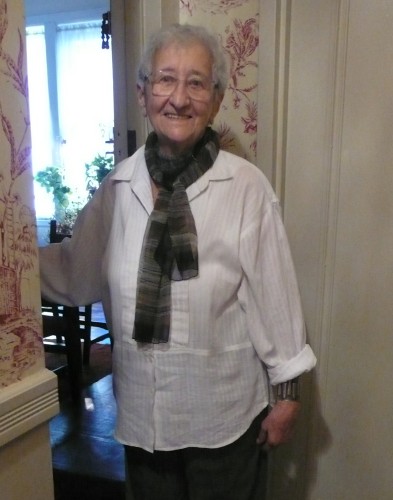
Tissa, greeting visitors as they get off the elevator. May 2012
This is exactly how I remember and will remember her.
A perfect photo.

Tissa’s good friend, artist Judith Reigl, drew this portrait
of Tissa in 1942. (Owned by Tissa’s sister, Katalin David.)
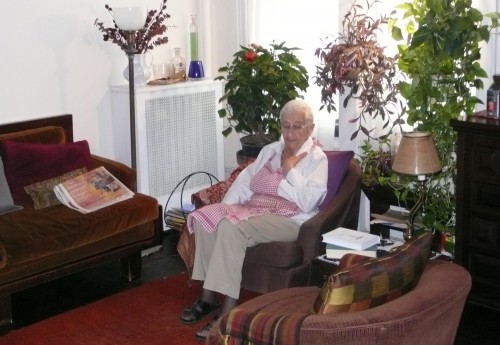
Tissa, sitting in her living room, May 2012
This is an amazingly beautiful photo.
Enlarge it for the full picture which is exact and accurate in its colors.
Years ago, I remember sitting through Fantasia at a private screening in John Canemaker‘s apartment. This was before the days of home video or dvd. John had secured a beautiful 16mm print for the occasion. This film was seminal to John’s life and spirit; I knew that and I suspect that Tissa also knew it. I’d also seen the film about 20 times in the year prior to that screening; it had just been re-released in NY for the first time in many years. I felt that the film had some of the greatest work of the Disney artists, and I also felt that it had some enormous lows.
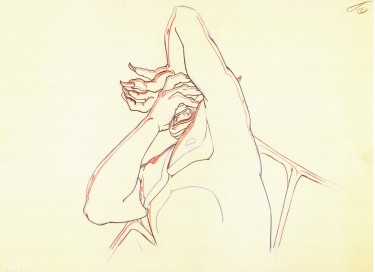 At the end of the film, Tissa immediately piped up and proclaimed it a horrible movie. (John used to impersonate Tissa’s comment for years after, and it always brought a laugh.) She was overstating her thoughts, obviously, but for comedic effect. She hated the Pastoral and other kitschy parts of the film, but she undoubtedly loved the brilliance of Bill Tytla‘s devil or the strength of Reitherman‘s dinosaurs. Even the excellence of Kimball’s Bacchus couldn’t be denied. However, the overall effect was questionable, especially in that apartment screening where it wasn’t the overblown big screen and stereophonic sound version, and its flaws were more obvious.
At the end of the film, Tissa immediately piped up and proclaimed it a horrible movie. (John used to impersonate Tissa’s comment for years after, and it always brought a laugh.) She was overstating her thoughts, obviously, but for comedic effect. She hated the Pastoral and other kitschy parts of the film, but she undoubtedly loved the brilliance of Bill Tytla‘s devil or the strength of Reitherman‘s dinosaurs. Even the excellence of Kimball’s Bacchus couldn’t be denied. However, the overall effect was questionable, especially in that apartment screening where it wasn’t the overblown big screen and stereophonic sound version, and its flaws were more obvious.
Tissa blew the same trumpet on many other Disney features. There was a Museum of Modern Art screening of Jungle Book with Eric Larson, Ken Anderson and Gilda Ratner present to talk. I had all I could do to stay awake during the film. (Those horrible voices – Phil Harris, please!) Finally, it ended, and Tissa whispered the opinion, “What a dreadful movie!” I could only laugh. I thought I was the only one with that opinion, and she was voicing my thoughts (and covering up the fact that I slept through it.) We laughed together.
She absolutely loved Frank Thomas’ squirrel sequence from Sword in the Stone.As a matter pf fact, she had a soft spot for a number of Thomas’ sequences.She also loved Marc Davis’ work. His Cruella de Ville certainly stood out. Tissa surprised me during Beauty and the Beast when she praised a half shot of Belle walking and said it was a good walk. (This was within the castle while a prisoner of the beast.) You couldn’t see Belle’s feet, but Tissa believed it. This was high praise from her. By then I’d been concentrating more on the direction than the animation, so I was glad she caught me not paying attention to the screen action. She woke me up again, in a different way this time.
There were many gems Tissa praised to the hilt. The first time we saw Caroline Leaf‘s film, The Street she was full of superlatives. Tissa was a judge in Ottawa when Norshtein‘s Tale of Tales won Best in Show, and it deserved it. We sat through that film many times together. We both loved it. The Quay Brothers confused much of the audience that year with their early film, Nocturna Artificialia, but she loved it. Sodid I, and we spent a lunch talking about it.
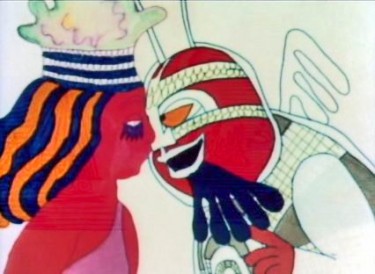 In 1974, she opted not to work on the Hubley film, Voyage to Next (she never told me the reason though I believe it was because John was lowering her salary considerably – he had so little money on this film – and she had to stand up for herself), but she praised, privately to me, the animation of Bill Littlejohn even though she wasn’t crazy about the final film.
In 1974, she opted not to work on the Hubley film, Voyage to Next (she never told me the reason though I believe it was because John was lowering her salary considerably – he had so little money on this film – and she had to stand up for herself), but she praised, privately to me, the animation of Bill Littlejohn even though she wasn’t crazy about the final film.
She shared a long list of things she didn’t like in her own work on films like Eggs, and Raggedy Ann. She also loved working on both films, and loved working for both directors – John Hubley and Dick Williams. After working on animation for Candide for Bob Blechman – low salary long hours and difficult but beautiful work – she told me privately that she would not work on any more films for Bob. She hated how the studio had reworked her animation and changed the cutting. She felt all her hard work had been damaged.
In short, I learned from Tissa that I should trust my judgement. I also used judicious thought in airing my opinion; I was always concerned about hurting the feelings of others. Tissa showed me that I had a strong and contrary opinion, but really I was just looking for my idea of quality. It was easy to say how much I liked things I didn’t, but it was hard to speak the truth and tried to articulate why. It isn’t always easy, but it’s certainly necessary for me. I suppose that makes me not always liked within the community, but the art of animation is too important for me. If my honest opinion gets someone to do better, it’s worth it.
Not too long ago an award winner at an animation festival offended me. At the after party, I told the film maker that his half of a walk cycle was an unforgivable cheat. The budget was the excuse that didn’t sit with me, and I stupidly hurt the animator/director. He hasn’t done half a walk cycle again, and I think my rudeness paid off. Especially in that he’s a gifted artist, and his work was better than what he offered us – even winning an award.
Tissa’s unforgiving critiques of my work, and there were many of them – many – over the years was always helpful. Every single comment from her, whether about my work or other people’s work, taught me something. The positives meant so much more because the negatives were just as honest. I’ll miss her barbs and her lessons. However, I have to say my own opinion of my work is more critical than she ever could have been. I just don’t have a second voice to back me up anymore, and I seriously miss that.
UPA Production Numbers
- Following in the lead of Thad Komorowski‘s listing of production numbers from M-G-M and Warner Bros cartoons, Adam Abraham has opted to add all Production Numbers, he has for the UPA films. This list is complete to about 1956 and includes all the Columbia shorts.
This site, When Magoo Flew, is not only a good companion to the book but is excellent and informative in its own rite. There’s plenty of information here that doesn’t even appear in the book.
Paul Rand . . . I mean Ayn Ryan
- For all those psychotic Paul Ryan lovers, Ayn Rand‘s The Fountainhead will be broadcast on TCM on Sunday, August 26 at 02:30 AM.
This gave me one of my favorite moments as an Academy member. It was a memorial service for Gary Cooper, who had died way back in 1961. They had clips from a number of his great films and a number of speakers who were part of his life (or he was part of their lives.) It was moving smoothly when Patricia Neal came to the microphone, dressed in a bright, slinky, crimson dress. She gave a short-ish speec which started with,”
“Gary Cooper was the love of my life.”
She revealed something that was obvious to many at the time. She and Cooper, while filming The Fountainhead, fell in love. Cooper was married and loved his wife. He would not leave his wife and child for Patricia Neal on her first film. The affair turned to an end. Neal was brokenhearted and told us, many years after. She told us she still loved Gary Cooper. It was a very emotional speech.
They followed with a clip from The Fountainhead.
Maria Cooper, Gary Cooper’s daughter, followed the clip and didn’t talk about Patricia Neal.
Olympiad Twenty
I’ve received a notice about the following animated short pieces geared to the Olympics. (Better late than never.) They’re very short animated clips that lead one into another. The note that came with the email read as follows:
- We’ve just made a series of 7 x 20 second animations in just two weeks with
one animator, which is getting really good feedback.
Wondered if you might like to see our animation and share it if you like?
Any feedback you can offer is most appreciated.
Kath Shackleton, Producer
Fettle Animation
Personally, I’m not the biggest fan of the material, however, I thought many of you would like them. The punchlines are consistently nasty and unpleasant, making the stories not very interesting to me. The animation seems excellent for Flash type work. A lot of labor went into them; I wish the writing had been more creative rather than nasty.
Please feel free to leave your comments for them; I’m sure many of you will like them more than I. It’s just my sentiment – my taste – in this period of world history.
Books &Commentary 28 Jul 2012 08:03 am
Books and Things
I’d received a note from Fraser MacLean this week. He’s the author of the brilliant and beautifully illustrated book, Setting the Scene: The Art & Evolution of Animation Layout. It was odd that I’d just been talking about his book when I’d heard from him. This got me to think that I might post a reminder of a couple of the excellent books that were released this year. I’d reviewed a number of them, and would like to keep them at the front of your mind, so to speak. Here are three easy picks to tell you about.
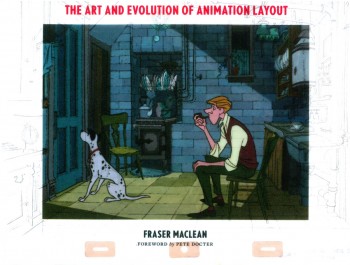 Setting the Scene: The Art & Evolution of Animation Layout is a book about Animation layout, obviously, and it belongs on every bookshelf of those who work in the medium or are interested in it. I guarantee your first visit to this book, though, will be your ogling the incredible illustrations. They’re just wonderful. From 101 Dalmatians to the Cobbler and the Thief, from Pixar to Dreamworks. It’s an attractive book.
Setting the Scene: The Art & Evolution of Animation Layout is a book about Animation layout, obviously, and it belongs on every bookshelf of those who work in the medium or are interested in it. I guarantee your first visit to this book, though, will be your ogling the incredible illustrations. They’re just wonderful. From 101 Dalmatians to the Cobbler and the Thief, from Pixar to Dreamworks. It’s an attractive book.
The book covers layout from the point of traditional 2D animation, preparing for the camera, as well as for the computer. It also covers the Layout of animation for cgi films. (See my full review here.)
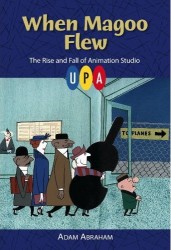 At the top of the list this year would have to be Adam Abraham‘s fine book, When Magoo Flew: the Rise and Fall of Animation Studio UPA. It is a gem. This is an intensely researched book about the studio that changed the direction of animation in the late 40s.
At the top of the list this year would have to be Adam Abraham‘s fine book, When Magoo Flew: the Rise and Fall of Animation Studio UPA. It is a gem. This is an intensely researched book about the studio that changed the direction of animation in the late 40s.
The book is a very political one, or at least it’s about the politics of the studio that grew out of the Disney strike and pushed on through the McCarthy hearings with their hot design influences. The politics also refers to the ins and outs of the studio, whether it’s John Hubley not liking Herb Klynn’s artwork or Jack Heiter losing his job for refusing to listen to Jules Engel‘s thoughts on color.
There’s a lot in this book and it’s a treasure for anyone interested in that studio or those people. It also helps that a brand-spanking-new DVD was released at the same time with many of the important films from the studio. Jolly Frolics, the UPA Collection. We’re still waiting for the Magoo Theatrical Films to be released, as promised, on DVD. Mr. Magoo:Theatrical Collection
This book also has a companion website, When Magoo Flew, hosted by the book’s author Adam Abraham. There’s material there which you won’t find in the book. (Se my fuller review here.)
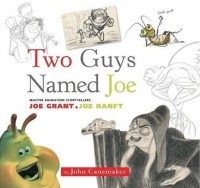 The third book I’ll mention here, is a big, lavish, picture book. Two Guys Named Joe: Master Animation Storytellers Joe Grant and Joe Ranft is the story of two story writers and artists working at opposite ends of the Disney Studio, and it was released almost a year ago today.
The third book I’ll mention here, is a big, lavish, picture book. Two Guys Named Joe: Master Animation Storytellers Joe Grant and Joe Ranft is the story of two story writers and artists working at opposite ends of the Disney Studio, and it was released almost a year ago today.
Joe Grant was one of the old timers who made it through the Golden Age in the 30s & 40s as well as the Golden Age in the 80s. He was a force in the studio, and brought some real art and artistry to the characters and designs he helped develop. Joe Ranft was a youngster who helped put Pixar on the map. His expertise in developing and telling stories made the early cgi features all that they were.
John Canemaker pulls their two stories together and showcases their lives and studio experiences to give an interesting viewpoint of the Disney studio. This is an unusual but excellent book, and in case it’s fallen off your radar, I might suggest you take another look if you don’t own the book. It’s a worthwhile volume to enter any animation collection. (View my full review here.)
Benzon’s Dumbo
On his blog, the New Savannah, Bill Benzon has focused in on Disney’s Dumbo and his in depth analysis features quite a few blogposts. Hearty reading for those of you who’d like to see more about this Disney great. (I sometimes think Bill is writing specifically for me; I love it.)
McLaren Animation – Tooned
Dennis Hermanson of Hillsborough, NC sent me a video that he thought I should post on the site. This is not really my kind of video. It’s trying to be Pixar and does a good job of it, but it doesn’t do anything to get me excited about animation. But I can see that it would excite others, so I decided to post it here, just the same. I hope you enjoy it.
Episode 01 (Wheel Nuts )
Daria
 MTV is offering something called MTV’s Retro Mania. But I come a bit late because it’s ending its Summer run with the return of Daria this next week. Some of their favorite Episodes from the New York produced show, Daria, will air Monday, July 30 until August 3, 2012 from 9:00am to 12:00pm.
MTV is offering something called MTV’s Retro Mania. But I come a bit late because it’s ending its Summer run with the return of Daria this next week. Some of their favorite Episodes from the New York produced show, Daria, will air Monday, July 30 until August 3, 2012 from 9:00am to 12:00pm.
If you miss that, you can go to the MTV website and watch episodes on line. Daria.
There was a time, I think, when this show was cool. I guess I have to catch up; I still haven’t made it through a show. I did root for the show to do well in that a lot of people who had left my studio went on to do work on the series.
Commentary 02 Jun 2012 06:30 am
Processing Onward
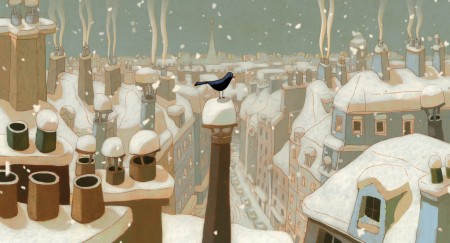
A Cat In Paris
- A Cat In Paris opened officially in New York, yesterday. You may remember that this film, a smidge longer than one hour, was one of five nominees this past year for the Best Animated Feature Oscar. It is a French film animated in 2D and is a satisfying film. It is far from great but also far from bad.
It was a year of films like Cars 2, the sequel to Pixar’s Cars, which had a budget north of $200 million, or Kung Fu Panda 2 the sequel to Dreamworks’ Kung Fu Panda with a budget of $150 million or Puss In Boots, the spin-off of a character from Dreamworks’ Shrek 2 with a budget of $130 million. Two of these three were also nominated for the Oscar (a hint – not the Pixar film.)
This film, The Cat In Paris, received a mix of reviews in NY. The NYTimes‘ A.O.Scott called it, ” . . . a refreshing reminder, at a time of large-scale, highly polished cinematic spectacle, of the essential, elemental sources of movie-watching pleasure.” There was no doubt that Mr. Scott was charmed with the film.
Lou Leminick of The NYPost gave it two stars and wrote, “. . . it seems slight and unremarkable, especially compared to two other wonderful French-language nominees in this category in recent years, “The Triplets of Belleville’’ and “The Illusionist.’’
Michael Atkinson of The Village Voice wrote, “A sketchy trifle of French animation grabbing time in theaters thanks to its recent Oscar nomination . . . seeks shelf space beside Sylvain Chomet’s deft and rapturous hand-drawn cartoons (The Triplets of Belleville, The Illusionist), and the required self-conscious Frenchiness is spot-on.”
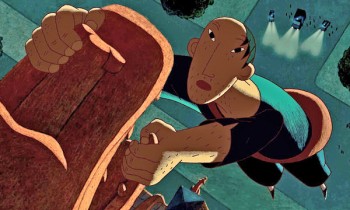 I saw the film last year toward the end of a two week screening of 18 animated features contending for the Oscar nomination. By the time I saw it, I’d been filled with horrendous cgi films like Alvin and the Chipmunks and Puss In Boots and, god help us, Hoodwinked 2. The Cat In Paris came over as the height of sophistication and whimsy. I’m sure I need to see the film again to properly judge it, but I do remember it as nicely designed in a European cartoon style, with a very nice music track and serviceable animation.
I saw the film last year toward the end of a two week screening of 18 animated features contending for the Oscar nomination. By the time I saw it, I’d been filled with horrendous cgi films like Alvin and the Chipmunks and Puss In Boots and, god help us, Hoodwinked 2. The Cat In Paris came over as the height of sophistication and whimsy. I’m sure I need to see the film again to properly judge it, but I do remember it as nicely designed in a European cartoon style, with a very nice music track and serviceable animation.
I enjoyed the movie and am certain I’d feel the same on viewing it again. My thoughts were closer to siding with Mr. Scott’s review in the Times. It wasn’t great; it wasn’t bad. It was a wholly entertaining hour.
- Tom Stathes is one of those incredibly dedicated people who’ve made animation history their life. As a result, the work he’s done, particularly for the silent animated film, has become an enormous contribution to the medium, especially given the internet’s total lack of interest in the subject. This is a rare focus that is wholeheartedly needed for the preservation of that part of the form.
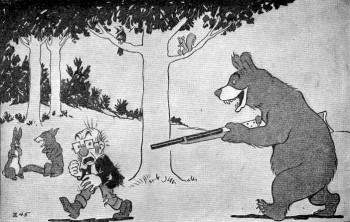 His establishment of the Bray Project has given attention to the studio that was certainly the first very large animation studio in the world with an enormous product and a strong control over the medium of the day. Established in 1911, the Bray Studio produced generally poor cartoons, (most silent cartoons of this period were poor films) but they allowed many pioneers to begin their careers on the right step. From Walter Lantz to Max Fleischer to Paul Terry, many of the giants sat in this studio first.
His establishment of the Bray Project has given attention to the studio that was certainly the first very large animation studio in the world with an enormous product and a strong control over the medium of the day. Established in 1911, the Bray Studio produced generally poor cartoons, (most silent cartoons of this period were poor films) but they allowed many pioneers to begin their careers on the right step. From Walter Lantz to Max Fleischer to Paul Terry, many of the giants sat in this studio first.
Mr. Stathes recently sent out this email note announcing that the Bray Project is now one year old. I thought it important to post the email and give a little nod to Tom and all the great work he’s doing.
- Dearest Friends and Colleagues,
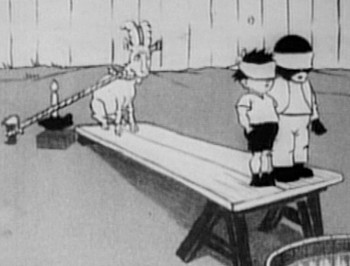 It is now one year since the Bray Animation Project website launched. And it’s been a great year at that!
It is now one year since the Bray Animation Project website launched. And it’s been a great year at that!
Many incredibly exciting rare film finds have been made since the site’s debut and I’ve shared a little bit of information about that in a special blog post here.
The Bray site will see some fixes, updates, and further add-ons in the near future. More excitingly, though, please keep posted for some very important announcements from yours truly to follow in the next few weeks. I once again invite interested parties to discuss research or post questions at the site’s discussion board.
Thank you all for taking an interest in this project or for being a supportive element in my film history and archiving endeavors in general. I wouldn’t be able to achieve much of what I have without the help of many of you.
Cordially,
Tom Stathes
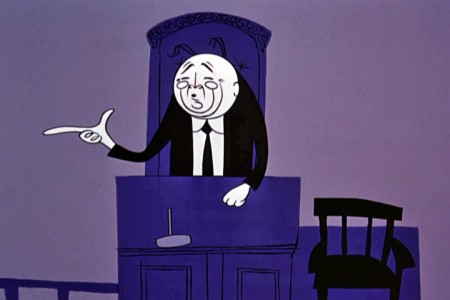 - Thad Komorowski is someone else who continually surprises me with the depth of his knowledge about animation history. I shouldn’t be taken aback whenever I go to his blog and column. The reportage is always first rate, thorough, and the subject is often something I hadn’t even thought about. Yet, a lot of research and work has gone into those columns, and I can only admire them and bookmark their pages so that I can come back and reread it another time or two.
- Thad Komorowski is someone else who continually surprises me with the depth of his knowledge about animation history. I shouldn’t be taken aback whenever I go to his blog and column. The reportage is always first rate, thorough, and the subject is often something I hadn’t even thought about. Yet, a lot of research and work has gone into those columns, and I can only admire them and bookmark their pages so that I can come back and reread it another time or two.
Often, Thad talks about the process rather than the ideology behind the animation. This week, for example, he wrote about the Technicolor backlog once WWII had ended. Studios working in IB Tech weren’t able to get their negatives developed or their print orders met. Waiting years to get their films to market had to have hurt the market, especially given the break up of theater monopolies by the studios. Some of the smaller studios had to turn to Cinecolor to get even second rate prints made. All to go to market.
Thad also gives us an example of a Columbia short that was printed on Cinecolor. We can see how lacking it is in its color quality, and we can also see how dreadful the cartoon is in the quality of its art. It’s one of those shorts you know is so bad you can’t understand why you’re continuing to watch it, yet it’s THAT bad that you can’t stop watching it. The Cinecolor is only the icing on the cake.
And speaking of process just read the posts The WB Production Number Project or MGM Cartoon Filmography by Production Number. These are all about accounting, but since it’s part of the principal production of those glorious Hollywood shorts, it’s information that should be relayed. And I have to say, in my fifty odd years of reading about animation and its history, this is the first time any of these subjecs has come up. It’s not something I need to know, but it’s something I’m astonished to realize I didn’t know. And, believe it or not, this is information I want to have.
As Thad’s work matures, so too his reviews. His lengthy review of Adam Abraham‘s book, When Magoo Flew, is a first rate look at Abraham’s work. It fairly points out the shortcomings of the book, but also tells how important this book is given the lack of other material available on the subject of UPA’s birth. More importantly, Thad has a separate blog post about the Jolly Frolics shorts.
Like most good reviews, there are treasures built into them. Thad appropriately assays Bobe Cannon‘s career in a short and on-target side note. Since Cannon directed many of the most famous UPA cartoons, this is entirely necessary.
- Bobe Cannon was one of animation’s most puzzling treasures. He came up through the ranks at Schlesinger’s and is said to have been critically involved with the concept of smear animation with Chuck Jones. He ultimately abandoned all of what was fun in his own animation in the cartoons he directed at UPA. There are still traces of it in “The Miner’s Daughter” and “Georgie and the Dragon,” and Cannon and Paul Julian (one of the studio’s real unsung heroes) also helmed “Wonder Gloves,” a vastly underrated cartoon with simple but highly pleasing design and animation.
I don’t always agree with Thad, but he gets me to read his evaluation and think about what he’s had to say. Something any good historian or writer would do. I enjoy attending to his blog and appreciate it every time there’s something new. If you’re as much a sucker for animation history as I am, you’ll want to do the same. What About Thad.
Animation Artifacts &Frame Grabs &Hubley &UPA 28 May 2012 06:21 am
The Four Poster
- One of the real neglects in animation history is the availability of The Four Poster in VHS, DVD or any other format. For some reason, this title has eluded marketers who’d want to cash in on the name of Rex Harrison or his wife, Lilli Palmer. Where’s TCM when you need them.
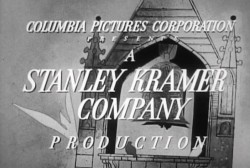 This film was a Stanley Kramer production directed by Irving Reis in 1952 of a play by Jan de Hartog. It tells the life story of a marriage between the husband and his wife. In fact, the film is so insular that it never leaves the bedroom, and it revolves around the “four poster” bed in that room. For the film, they chose to open it up by leaving the bedroom via animated inserts done by John Hubley at UPA. There are some 20 minutes of the film done by Hubley/UPA, and it’s extraordinarily progressive animation for the time.
This film was a Stanley Kramer production directed by Irving Reis in 1952 of a play by Jan de Hartog. It tells the life story of a marriage between the husband and his wife. In fact, the film is so insular that it never leaves the bedroom, and it revolves around the “four poster” bed in that room. For the film, they chose to open it up by leaving the bedroom via animated inserts done by John Hubley at UPA. There are some 20 minutes of the film done by Hubley/UPA, and it’s extraordinarily progressive animation for the time.
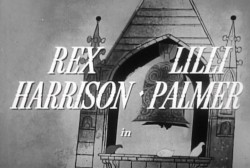 I own a good 16mm copy of the whole film, and cut the animation segments separate from the feature, I allowed a friend to make a video copy but was very disappointed with the results – out of focus and almost unwatchable. In the past couple of weeks, another friend led me to a second DVD copy which is also out of focus but not as bad as the first.
I own a good 16mm copy of the whole film, and cut the animation segments separate from the feature, I allowed a friend to make a video copy but was very disappointed with the results – out of focus and almost unwatchable. In the past couple of weeks, another friend led me to a second DVD copy which is also out of focus but not as bad as the first.
I’ve wanted to focus on this film for some time, hence I decided not to wait any longer and am sharing frame grabs with you of this muddy, soft focus version. You can still get the idea. If another, better copy turns up in the future, I’ll rework these images and repost it.
Here are bits from the opening credits. Lots of traveling right and then left and then right again.
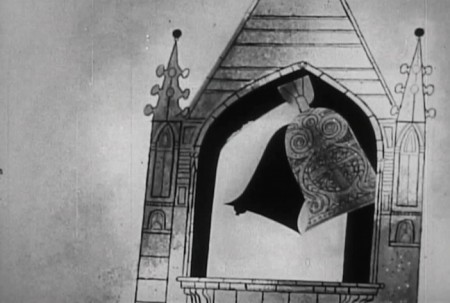 3
3The film does get very claustrophobic staying in the one bedroom set
for the entire film, with just the two characters, husband & wife, to talk
us through most of the movie. It’s exhausting.
This makes the animation more welcome than it would ordinarily be.
You’re dying for any excuse to change scenery and move the story forward.
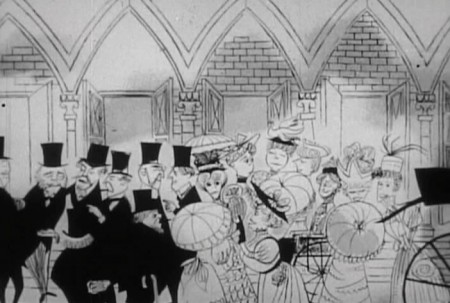 4
4
On top of this, the live action is very theatrical
whereas the animation is full of life and quite lyrical.
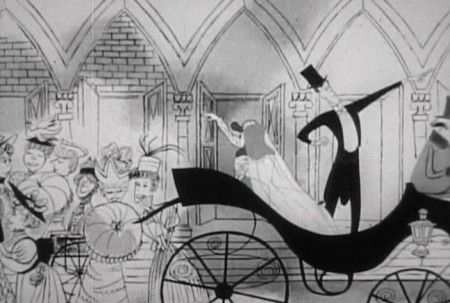 5
5
The animation does reveal a good part of the story from the
birth of their boy to his death in WWI on the front lines.
(Hubley designs one of his greatest sequences for this one.)
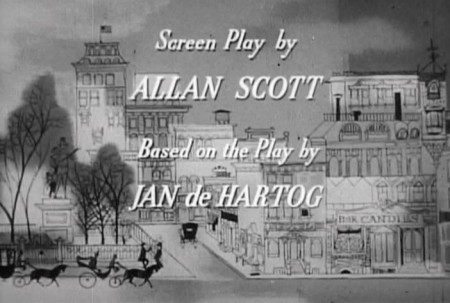 8
8
Supposedly, the film was sent to Yugoslavia for a run.
Some of the people in Zagreb were able to kidnap the film
and hold onto it for a number of additional weeks. They
studied it closely and copied it.
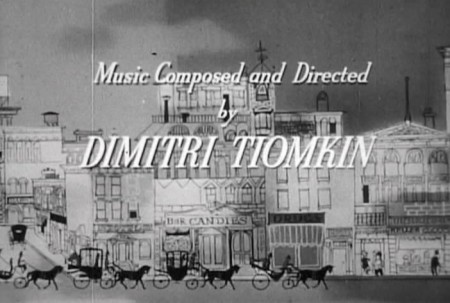 9
9
When they were finished the print was returned to
the States, and they started up Zagreb animation with their
new-found knowledge and inspiration. A bit more than inspired,
shall we say. How very 21st Century of them
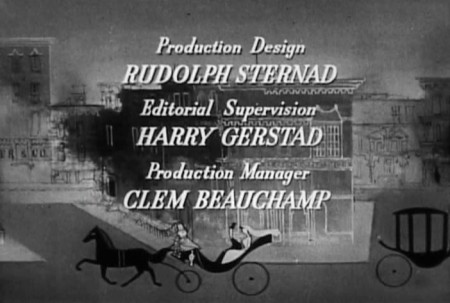 12
12
In his book, When Magoo Flew, Adam Abraham doesn’t give a lot of
space to the work on this feature. However, every small comment
seems valuable since so little has been written about this film.
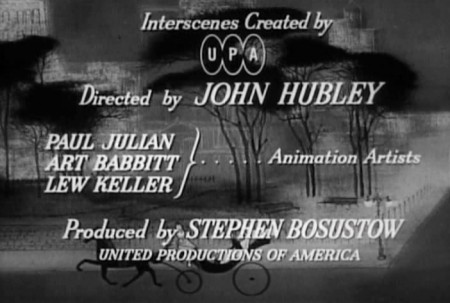 13
13
Abraham says that Hubley and crew went onto this directly after
finishing Rooty Toot Toot. They were broken into small groups
with each group doing one of the interecenes in the feature.
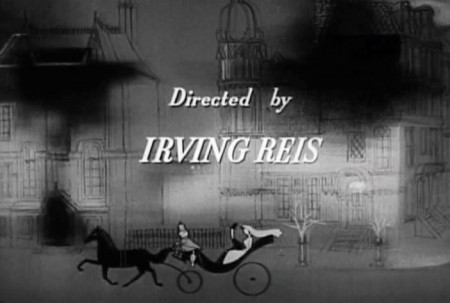 15
15
Paul Julian oversaw the stylistic representation of the War
and Art Babbitt animated the sequence showing the effect
of the war on the soldiers coming home.
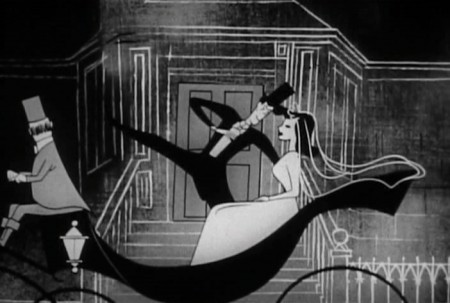 16
16
In total, it’s an enormous accomplishment.
____________________
.
The first animated intersection shows the Rex Harrison character going off to work as a teacher in a boys’ school.
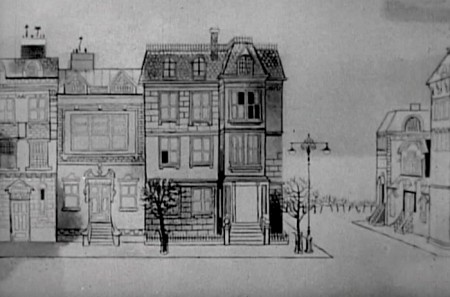 1
1
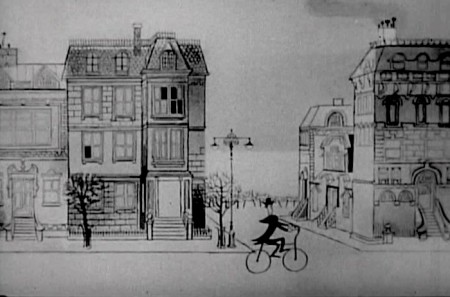 2
2
Out of the home, Rex Harrison’s character
comes cycling on his way . . .

. . . to school. Like many other sequences in this animation,
he rides a long pan to the school where he enters on bike.

Inside the school, we echo the first scene with another pan.
This time we pan from class to class ending with . . .
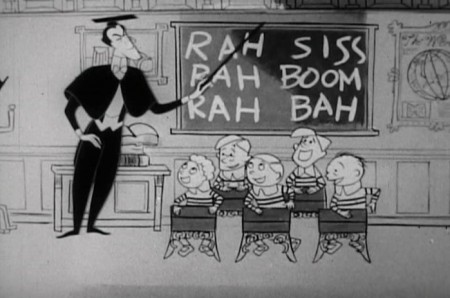 5
5
. . . Rex Harrison’s very unethical class, where the kids are having fun.
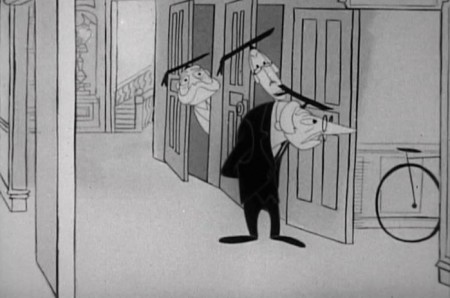 8
8
The raucus noise of his class is disturbing other teachers.
They don’t like the students having fun.
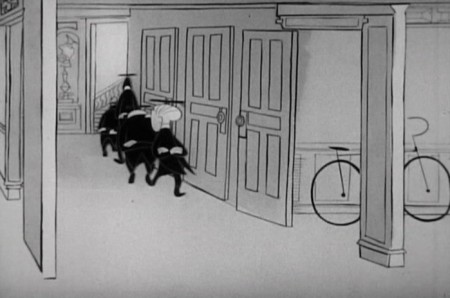 11
11
Off to the Dean’s office to complain.
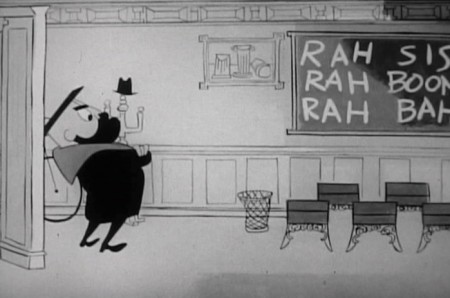 16
16
The Dean breaks in to something too much fun.
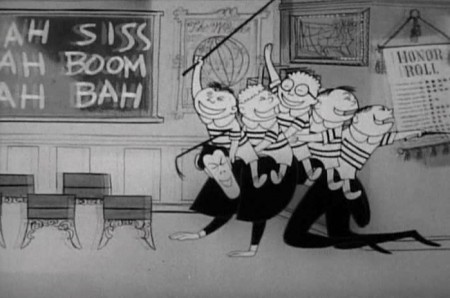 17
17
Even with the soft focus, you can see
that the character design is great.
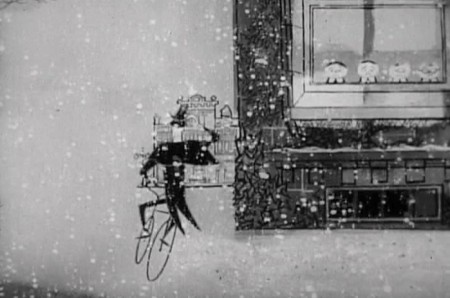 20
20
He goes off into the sunset of a
snow fall.
Back to live action
Commentary 28 Apr 2012 07:57 am
Busyness
- Tomorrow, we will be opening our new Indiegogo page reintroducing the Poe Project to you. We’ll start with much the same offering we did for the Kickstarter run. However for the length of time this is up, we’ll be writing about the film and Edgar Allan Poe on our site on Sundays. Our goal is about half of what we aimed for last time, but we’re encouraged that we’ll be able to get there this time and will be working on POE soon.
Stark Raven Mad
- The Raven makes its way into theaters this week, and I saw it last Tuesday. This is a film starring John Cusack as Edgar Allan Poe. He’s pulled into service consulting with the police on a serial murderer’s killing of numerous people using ideas copied from Poe’s own stories. If Poe wants to save his young fiancée, he has to work hard at producing several new stories built on ideas he gets from the work of the killer. The flilm is ridiculous and tries to be a variant of the Robert Downey jr. Sherlock Holmes movies. Action, action, action with erroneous snippets about Poe and his life.
The film starts with an inaccuracy and goes wildly from there. The title card reads that Poe was found dying on a park bench. In fact, he was found acting wildly outside of a tavern known as Gunner’s Hall or Ryan’s Tavern. With this false premise the film is allowed to end with E.A.Poe dying, in the fresh snow, on a park bench, alone. In fact, he died another four days later after being placed in a pauper’s hospital where he wasn’t allowed visitors.
I noticed the Rotten Tomatoes average of 20% positive reviews for this film. Not good at all, but I’d expect that’s accurate.
The death of Poe has become a real mystery thanks to the poor reporting of his biographer, Rufus Wilmot Griswold. He had published a couple of Poe’s poems, received a very negative review from Poe, and the two became strong rivals. Griswold later published the first biography of Poe picturing him as a depraved drunkard and a drug-addicted madman. Despite objections from those who knew the truth, this negativ image of Poe remains even to this film in 2012.
Poe spent the evening of his death having dinner with three friends, during which he did not drink alcohol. He then went to the train station where he bought a ticket for a later train to Philadelphia, which he was to catch that evening. From this point to that, when he was found delirious on the streets outside Gunner’s Hall, there is nothing known for sure.
Pirates
- On the Academy’s double bill with The Raven was the new Aardman animated feature, The Pirates: Band of Misfits. The film is well executed; the models are attractive, the detail in the sets is exceptional, and the animation is first rate (although there was something odd going on at times which made me wonder if they’d shot it at the European gauge of 25 fps.). Just the same, it was nice to see 3D puppets as opposed to 3D cgi. The look of this film was so much better than the slick Arthur’s Christmas. One can only hope that Aardman sticks to what they do best – stop motion.
The film is funny. In fact, that was a bit of a complaint I had. It was gag, gag, gag, so that you end up laughing fewer and fewer times. Yet, the big story was inconsequential and felt, to me, as though it had no real drive. The film revolves around the “Pirate Captain” (that’s his name) who wants to win the “Pirate of the Year” award and has to meet a self-imposed challenge to win the award. (Sort of like wanting to win an “Oscar” and making a film with that goal in mind.) This makes for too small a story to keep me captivated, and I felt outside the film for the entire time watching. I checked my watch often enough for this 90 minute movie. Essentially, I found the film is OK, but not necessary. Not quite as strong as Chicken Run.
ASIFA East Fest
Tomorrow, April 29th, Sunday 7pm, ASIFA-East presents
The 43rd ASIFA-East Animation Awards
The Awards will be presented, followed by a free food & drink reception.
Again, the admission is FREE! And it’s open to all!
The New School
Tishman Auditorium
66 W. 12th Street
(bet. 5th/6th Aves)
NYC
UPA On Line
- Adam Abraham is the author of the new and brilliant book, When Magoo Flew, the history of UPA. He wrote me to introduce his new site, also named When Magoo Flew. The site acts as an archive of his UPA research material, and it’s a new an attractive addition to the animation net. I’ve added a link to my blogroll on the right.
Honor
RIchard O’Connor of Ace and Son sent me this link to a film they just completed and which debuted this week at the Tribeca Film Festival. Richard wrote this about the animation:
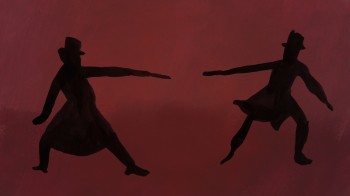 It was an interesting project and we were pretty much given a video edit of the talking head footage and left to our devices to make it work. There was a need to have a “historical” look countered with the need for fluidity/looseness and I think we came up with a good middle ground. Everything is painted on paper with the line on a separate level (I wanted to do it all on one piece of paper but we ran out of Ingram bond and the cheap stuff caused horrible bleeding AND Cartoon Colour took a month to get us another shipment). You can see where sometimes the tracebacks aren’t there for the paint level.
It was an interesting project and we were pretty much given a video edit of the talking head footage and left to our devices to make it work. There was a need to have a “historical” look countered with the need for fluidity/looseness and I think we came up with a good middle ground. Everything is painted on paper with the line on a separate level (I wanted to do it all on one piece of paper but we ran out of Ingram bond and the cheap stuff caused horrible bleeding AND Cartoon Colour took a month to get us another shipment). You can see where sometimes the tracebacks aren’t there for the paint level.The coloring looks more like marker on cel, to me, than color on paper. Quite a difficult look to pull off. I’d be curious to see what it looks like on the big screen.
An ArtsEngine, Inc. Production
EDITED BY – Gabriel Rhodes
MUSIC COMPOSED BY – John Kimbrough
ANIMATION BY – Ace & Son Moving Picture Company
ANIMATION DIRECTOR – Richard O’Connor
DESIGN/LEAD ANIMATOR – Kelsey Stark
ADDITIONAL ANIMATION – Liesje Kraai
PRODUCTION ARTIST – Dee Mackey
CAMERA – William Rexer II
SOUND – John Zecca
RESEARCHER – Danielle Varga
PRODUCTION ASSISTANT – Justine Pierce
SPECIAL THANKS – Kwame Anthony Appiah
